Category: Food
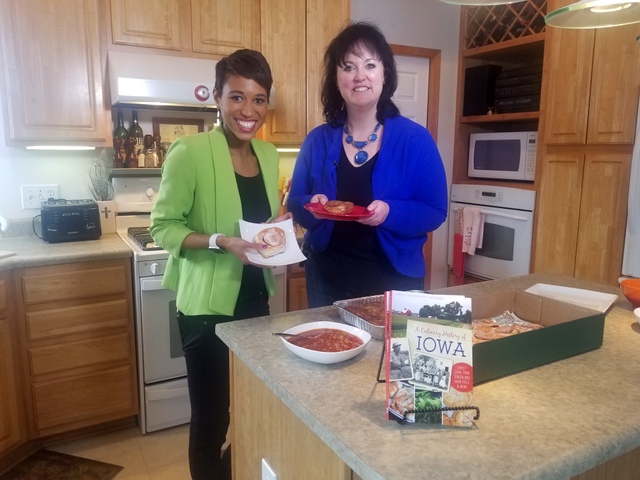
Are You on Team Cinnamon Roll?
It’s every marketer’s dream–a topic so compelling that no one can ignore it, and everyone wants to talk about it. Here in Iowa, this kind of topic revolves around that school-lunch classic–chili and cinnamon rolls.
Yep, it’s a thing, and it’s a beloved tradition here in my hometown of Lake City. I’ll never forget the comforting aroma of homemade rolls (caramel rolls, most of the time) filling the school, including our 1920s-vintage three-story high school. As if it weren’t hard enough to concentrate in math class, I had that enticing aroma to distract me–but oh what sweet torture!
I’m reliably informed that chili and cinnamon rolls are still a favorite school lunch in the local school district, as well as other schools around the state.
So when it was time to write the manuscript for my second book, “A Culinary History of Iowa,” I started talking to sources about the history of chili and cinnamon rolls. Not only did I discover that no one seems to remember the origins of this phenomenal combo, but it’s not something that every Iowa school kid grew up with.
Some people had never heard of it. Others said their school served peanut butter sandwiches with chili. There were those who couldn’t imagine chili without cornbread. Still others, including a friend from Minnesota, were revolted. “That makes no sense! That’s like eating scrambled eggs and birthday cake together!” said one Minnesota native.
Whether you love it or hate it, seems like everyone has an opinion about chili and cinnamon rolls. Click here for a snippet from my Culinary History of Iowa book to help whet your appetite about the history of chili and cinnamon rolls–along with an amazing recipe!
This food combo is also a surprisingly newsworthy topic. A reporter from the Des Moines Register interviewed me for the recent article “The history behind Iowa’s unique taste for chili and cinnamon rolls.”
The day after that story ran, I received an email from Jodi Long, a reporter for TV-13, the NBC affiliate in Des Moines. She wanted to do a segment on the history of chili and cinnamon rolls, so we filmed the segment last Friday. As soon as it aired on the early morning news segment this past Monday, I started getting comments, kudos and questions on Facebook and beyond.
(I love the Team Cinnamon Roll and Team Cornbread idea that Jodi included in her Facebook post. To watch the news segment, click here!)
I learned three things from this experience:
1. Realize that things you take for granted might be quite newsworthy, and look for ways to showcase these stories. (Your website, newsletter, e-newsletter, social media posts, press releases, videos, podcast or other communication tools might be just the place to share these stories.)
2. Respond quickly when the media wants to interview you about a topic. Reporters need to know sooner rather than later whether you can help them. Don’t miss the opportunity for free publicity.
3. Invite people to join the conversation. So I want to know–are you on Team Cinnamon Roll or Team Cornbread?
Want more?
Thanks for stopping by. I invite you to read more of my blog posts if you value intriguing Iowa stories and history, along with Iowa food, agriculture updates, recipes and tips to make you a better communicator.
If you like what you see and want to be notified when I post new stories, be sure to click on the “subscribe to blog updates/newsletter” button at the top of this page, or click here. Feel free to share this with friends and colleagues who might be interested, too.
Also, if you or someone you know could use my writing services (I’m not only Iowa’s storyteller, but a professionally-trained journalist with 20 years of experience), let’s talk. I work with businesses and organizations within Iowa and across the country to unleash the power of great storytelling to define their brand and connect with their audience through clear, compelling blog posts, articles, news releases, feature stories, newsletter articles, social media, video scripts, and photography. Learn more at www.darcymaulsby.com, or e-mail me at yettergirl@yahoo.com.
If you’re hungry for more stories of Iowa history, check out my top-selling “Culinary History of Iowa: Sweet Corn, Pork Tenderloins, Maid-Rites and More” book from The History Press. Also take a look at my latest book, “Dallas County,” and my Calhoun County” book from Arcadia Publishing. Both are filled with vintage photos and compelling stories that showcase he history of small-town and rural Iowa. Order your signed copies today! Iowa postcards are available in my online store, too.
Let’s stay in touch. I’m at darcy@darcymaulsby.com, and yettergirl@yahoo.com.
Talk to you soon!
Darcy
@Copyright 2019 Darcy Maulsby & Co. Blog posts may only be reprinted with permission from Darcy Maulsby.
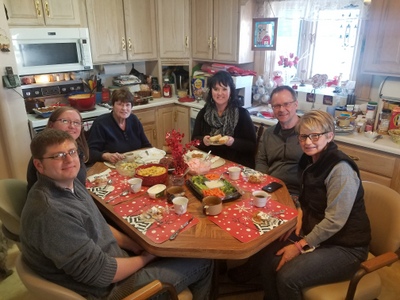
From My Kitchen to Yours: Comfort Food, Conversation and Living History Farms
Ever get an email that jumps out at you? It happened me to last July when one arrived with the subject line “Greetings from Living History Farms.” It was from my friend, Jim Dietz-Kilen, a former classmate from the Ag-Urban Leadership Initiative, and his note intrigued me.
“I have an idea for your consideration,” wrote Jim, who is the vice president of development for Living History Farms (LHF). “We are planning our annual gala, Farmstasia. We try to put together unique experience packages for our auction, with emphasis on agriculture/rural life and Iowa history. My idea is to build a package around you. While I am very open to other ideas, I wanted to run the following request by you:
• Would you be willing to donate a signed book? Any of your books would be wonderful, but I am partial to the Culinary History of Iowa.
• Would you also be willing to host a family at your farm to show them a bit of what your lives are like?
• Finally, would you be willing to serve these guests a meal selected from your book?
I know this is asking a lot, Darcy, but I have learned that you never know until you ask. And, as Wayne Gretzky said, ‘Every shot you don’t take is a miss.'”
By this point, I was already brainstorming menu ideas.
I’m a big fan of LHF, which welcomes between 100,000 and 110,000 each year. This interactive, 500-acre outdoor museum that tells the amazing 300+ year story of how Iowans transformed the fertile prairies of the Midwest into the most productive farmland in the world. As I wrote in this blog for Latham Hi-Tech Seeds, I love how LHF encourages people of all ages to explore Iowa’s rural heritage, including the 1700 Ioway village, the 1850 pioneer farm, the 1875 town of Walnut Hill and the 1900 horse-powered farm.
“All proceeds from Farmstasia go to keep fees low for our education programs, helping make it possible for kids from across the state to come here for school visits and participate in other educational experiences,” Jim continued.
Jim knows what is near and dear to my heart. Iowa agriculture. Books. Classic Iowa farm cooking. LHF. Giving back to the community. Without hesitating, I said yes.

Living History Farms Iowa
Cookstoves, corncobs and storytelling
LHF came into my life in a big way in the summer of 1995, when my college internship led me to the 1900 farm, Flynn mansion and veterinary clinic, where I served as a historical interpreter and looked the part in my Victorian-inspired dresses and bonnets.
That summer changed my life in so many ways. I met my husband through this experience. I also expanded my cooking skills. By the end of the summer, I knew how to light a cookstove with crumpled newspapers and corncobs. I could make homemade noodles with no problem. I could bake cookies in an oven with no temperature gauge, other than the feel of the heat on your hand. I could milk a Jersey cow by hand and churn the cream into butter. I could plan a meal and feed a threshing crew. I could even run a treadle sewing machine and sew my own apron.
Looking back, I was a prepper in training who can live off the grid if I have to.
While I don’t use all those skills today, some have served me well for years, especially the cooking skills, the historical knowledge I gained and the storytelling skills I learned. As a historical interpreter, I was not only working in the kitchen of the 1900 farm fixing a meal, but I interacted with guests. As I shared stories about Iowa farm life in the early 1900s, I learned the importance of listening. I’m still embarrassed when I misunderstood one guest who asked, “Is that a coal stove?” but I heard him say, “Is that a cold stove?” so I replied, “No, it’s a warm one!”
Planning a memorable menu
I was thinking of those experiences last Saturday, February 16, when I delivered on my promise to provide the Farmtasia winning bidders with an authentic Iowa farm meal inspired by my book. I had actually started cooking the night before and then got up early on Saturday morning so I’d get everything done on schedule and have time to visit with my guests.
They pulled in the driveway at my family’s Century Farm near Lake City right on time. It was an honor to host Dave Bubeck, a corn breeder at Corteva Agriscience™ in Johnston; his wife, Denise; and their friends Ben and Michelle Parlett, who also live in the Des Moines area. As we gathered around the table at noon, I served:
• Garden Vegetable Soup
• Homemade Beer Bread
• Iowa Ham Balls
• Glazed Meat Loaf
• Garlic Cheesy Smashed Potatoes
• Relish tray and coleslaw salad
• Homemade apple crisp with Haralson apples grown on our farm
There was something magical happened as we sat in that 100+plus-year-old kitchen, talking farming, food, travel and LHF. Seems like we covered everything, from how to talk about GMOs to what it’s like subscribing to a meal delivery service. Two and a half hours later, when my guests departed, we all agreed it was a great experience—the kind of story-worthy experience that LHF inspires. Even better, we’re staying in touch through social media and my e-newsletter.
And to think it all started with a simple email and a spirit of service. It reminds me of this quote from Orison Swett Marden, who founded SUCCESS magazine in 1897.
“We must give more in order to get more. It is the generous giving of ourselves that produces the generous harvest.”
Let’s get cooking
If you’d like to create a taste of our classic Iowa farm dinner, here are some of my favorite recipes:
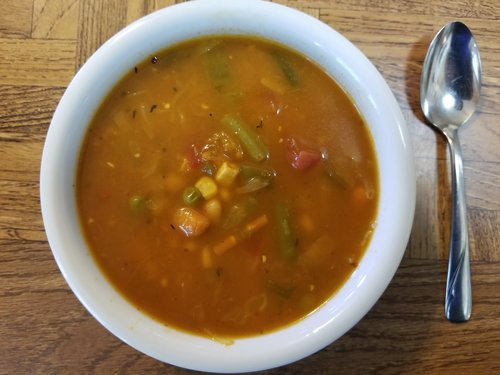
Hearty Homemade Vegetable Soup
Hearty Garden Vegetable Soup
I shared this tasty recipe in one my my monthly diary entries in 2018 for the Iowa Food and Family Project.
1 tablespoon olive oil
8 medium carrots, sliced
3 large onions, chopped
5 celery ribs, chopped
1 large green pepper, seeded and chopped
1 garlic clove, minced
2 cups chopped cabbage
2 cups frozen cut green beans (about 8 ounces)
2 cups frozen peas (about 8 ounces)
1 can (15 ounces) corn, or 2 cups fresh sweet corn
1 can (28 ounces) diced tomatoes, undrained
2 bay leaves
2 teaspoons chicken bouillon granules
1-1/2 teaspoons dried parsley flakes
1 tablespoon seasoning salt
1 teaspoon dried marjoram
1 teaspoon dried thyme
1/2 teaspoon dried basil
1/2 teaspoon pepper
7 cups water
1 teaspoon Worcestershire sauce
4 cups V8 vegetable juice
In a stockpot, heat oil over medium-high heat; sauté carrots, onions, celery and green pepper until crisp-tender. Add garlic; cook and stir 1 minute. Stir in remaining ingredients; bring to a boil. Reduce heat; simmer, covered, until vegetables are tender, 1 to 1-1/2 hours. Remove bay leaves.
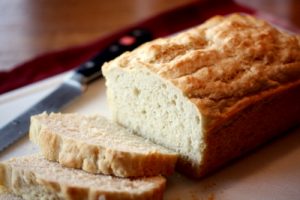
Best Beer Bread
Best Beer Bread
2 cups self-rising flour
2 1 / 2 tablespoons sugar
1 12-ounce can of beer
Mix all ingredients together. Pour batter into a greased loaf pan. Bake at 350 degrees for 45 to 50 minutes.

Iowa Ham Balls
Iowa Ham Balls
This tasty, classic recipe comes from my friend Val Plagge, who is a wonderful farm cook.
2.5 pounds ham
2 eggs
1 1/2 cups graham cracker crumbs
1 cup milk
1 can tomato soup
3/4 cup brown sugar
1/4 cup white vinegar
1 teaspoon ground mustard
With a food processor, grind ham into small, chopped pieces (or buy ham loaf mix from local grocery store or butcher. This mix usually contains ham and ground pork, and sometimes ground beef, too). Add eggs, graham cracker crumbs and milk. Mix together with your hands, and form fist-sized ham balls. (If the mixture seems a little dry, add 1/4 cup of milk at a time, up to 1 1/2 cups of milk total.) Place ham balls in a greased 9-inch by 13-inch pan. They fit nicely three across and five down.
Mix soup, brown sugar, vinegar and mustard until smooth. Drizzle glaze over the ham balls for the classic ham ball sauce. (Or, if you’re in a rush, drizzle your favorite barbecue sauce over the ham balls.) Bake at 350 Fahrenheit for 1 hour. Yield: 13-15 ham balls
Note: These ham balls freeze well and can be warmed up in a slow cooker, if desired. Ham balls are the perfect Iowa potluck treat!
Cheesy Garlic Mashers
Taking a twist on classic mashed potatoes, this recipe is loaded with flavor and offers the perfect comfort food.
Red Bliss or Yukon gold potatoes (use about one potato per person, although this will depend on the size of the potatoes)
6 garlic cloves (can use less, if you prefer)
Butter, 1 / 2 stick
Cream (use enough to give mashed potatoes the consistency you prefer)
1 carton sour cream (can substitute one carton of chip dip, if you prefer)
1 / 2 cup to 1 cup of Cheddar cheese
Seasoning salt and pepper, to taste
Chives, chopped
Bacon, 2 to 3 slices, fried
Boil potatoes in salted water with peeled, whole garlic cloves. When potatoes are done cooking, drain potatoes and garlic and place in a bowl with butter and cream. Mash together. Add more cream, if necessary, to achieve the consistency you prefer. Mix in sour cream and cheddar cheese. Season to taste with seasoning salt and pepper. Garnish with chopped chives and real bacon bits.
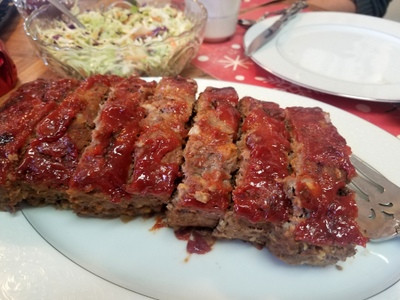
Glazed Meatloaf
Darcy’s Best Brown-Sugar Meatloaf
This recipe was inspired by the meatloaf that caterers prepared on the set in Iowa for the filming for “The Bridges of Madison County.” This is the only meatloaf recipe you’ll ever need!
1 pound ground beef
1 pound ground pork or ground turkey
1 cup herb-seasoned stuffing mix
1 onion, chopped
1 teaspoon salt
1/2 teaspoon freshly-ground pepper
1 teaspoon nutmeg
2 large eggs, lightly beaten
3 / 4 cup milk
2 tablespoons barbecue sauce
1 / 4 cup ketchup
2 tablespoons brown sugar
1 teaspoon dry mustard
Combine beef, pork or turkey, stuffing mix, onion, salt, pepper and nutmeg. In a separate bowl, beat eggs, milk, and barbecue sauce. Add to meat mixture, mixing well. Press into a meatloaf pan sprayed with non-stick cooking spray.
Combine ketchup, brown sugar, and mustard; spread over top of meat loaf. Bake, uncovered, at 350 degrees F for 1 hour and 30 minutes or until a thermometer inserted in the center of the loaf registers 160 degrees. Yield: 6 servings
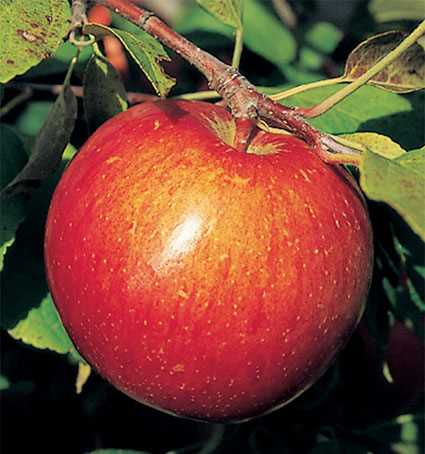
Haralson apple photo from Jung Seed
Farm-Fresh Apple Crisp with Whipped Cream
If you have the chance to visit a local apple orchard, pick up some Haralson apples, if they are available. We grow Haralsons on our farm, and their sweet-tart flavor works perfectly in apple pies and apple crisps.
Fruit Filling:
6 baking apples, peeled, cored and cut into wedges
1 tablespoon lemon juice
1 / 2 cup sugar
2 tablespoons flour (maybe need more, depending on how juicy the apples are)
Crumb topping:
1 1 / 4 cups flour
1 / 2 cup rolled oats
1 / 2 cup light brown sugar
1 / 2 teaspoon ground cinnamon
1 / 4 teaspoon salt
12 tablespoons butter (1 1/2 sticks), cut into small pieces
Preheat the oven to 350 degrees Fahrenheit.
For the fruit filling:
In a large mixing bowl, toss together the apples, lemon juice, sugar, and flour. Pour the apple mixture into a buttered 2-quart baking dish and set aside.
For the topping:
In a large mixing bowl, mix the flour, rolled oats, brown sugar, cinnamon, and salt. With a pastry blender, work the butter into the flour mixture just until mixture comes together and pea-sized clumps form.
Sprinkle the topping evenly over the fruit. Bake the apple crisp until the fruit is bubbling and the topping is golden brown and crisp, about 45 minutes.
Serve the crisp warm with vanilla bean ice cream or fresh whipped cream, if desired.
To make whipped cream, pour 1 cup of whipping cream into metal bowl on stand mixer. (Chill the bowl and whip attachment in the refrigerator first.) Begin mixing on high speed. As the cream starts to form into whipped cream, add powdered sugar a tablespoon at a time, until you achieve the sweetness you desire. Continue mixing on high until the mixture looks like thick whipped cream. Serve with apple crisp.
Want more?
Thanks for stopping by. I invite you to read more of my blog posts if you value intriguing Iowa stories and history, along with Iowa food, agriculture updates, recipes and tips to make you a better communicator.
If you like what you see and want to be notified when I post new stories, be sure to click on the “subscribe to blog updates/newsletter” button at the top of this page, or click here. Feel free to share this with friends and colleagues who might be interested, too.
Also, if you or someone you know could use my writing services (I’m not only Iowa’s storyteller, but a professionally-trained journalist with 20 years of experience), let’s talk. I work with businesses and organizations within Iowa and across the country to unleash the power of great storytelling to define their brand and connect with their audience through clear, compelling blog posts, articles, news releases, feature stories, newsletter articles, social media, video scripts, and photography. Learn more at www.darcymaulsby.com, or e-mail me at yettergirl@yahoo.com.
If you’re hungry for more stories of Iowa history, check out my top-selling “Culinary History of Iowa: Sweet Corn, Pork Tenderloins, Maid-Rites and More” book from The History Press. Also take a look at my latest book, “Dallas County,” and my Calhoun County” book from Arcadia Publishing. Both are filled with vintage photos and compelling stories that showcase he history of small-town and rural Iowa. Order your signed copies today! Iowa postcards are available in my online store, too.
Let’s stay in touch. I’m at darcy@darcymaulsby.com, and yettergirl@yahoo.com.
Talk to you soon!
Darcy
@Copyright 2019 Darcy Maulsby & Co. Blog posts may only be reprinted with permission from Darcy Maulsby.

What To Do When the Travel Channel Calls
Just how far can things go when you tell agriculture’s story? Turns out your message might just resonate with a national audience.
For me, it all started with a simple email on June 15. I was checking inbox that morning when I saw a note with the subject line “Bizarre Foods: Delicious Destinations– Researching Iowa.”
Could this be THE Delicious Destinations show on the Travel Channel? The channel filled with some of the best food and travel stories anywhere on TV? The stuff I love watching on the weekends when I’m actually home and have a few hours to relax?
Yes, yes and yes.
The note came from Lauren Shaffer, a researcher with “Bizarre Foods Delicious Destinations.”
“Each of our episodes feature a different city and the edible icons that make it a delicious destination,” wrote Lauren, who included an online link to the show. “We’re looking at doing a Des Moines episode in our upcoming season, and I’d love to get your opinion on what you think are the must-eats that make Des Moines, and Iowa in general, so special. Right now, we’re looking at sweet corn, pork tenderloin and Maid-Rite sandwiches, to name a few. I’ve downloaded your book, A Culinary History of Iowa, on my Kindle, and I am excited to get started on it!”
Rule number one when you receive a media request—respond as quickly as possible.
Within minutes, I replied to Laruen that I would love to help. We set up a time to chat over the phone within the week. During our conversation, which lasted almost an hour, I had a great time sharing my thoughts on what makes Iowa’s culinary history unique, how our foods are tied to our rich agricultural heritage and what I thought were some iconic Iowa foods that should be part of the show (from breaded pork tenderloins to Dutch letters to Maid-Rites to sweet corn).
On July 12, I received a new email with the subject line “Food Expert – Travel Channel Food Show – Iowa.” This one came from Lauren’s colleague Stacie Buszmann, segment producer with Tremendous! Entertainment, which produces Delicious Destinations. (I love how the company says it specializes in telling great stories through passionate characters who want to change the world.)
Stacie asked if she could visit with me over the phone to get more input on the Iowa episode. We talked about not only potential stories, but logistics. What would make sense, given the timing of the filming (four days in August to coincide with the great 2018 Iowa State Fair) and how the TV crew would be based in the Des Moines area during their time in Iowa?
Then came the biggest surprise. “Would you be willing to be our food expert?” Stacie asked. “We’d love for you to meet the crew for your interview at The Corn Stand in the Varied Industries Building at the Iowa State Fair on Monday, August 13.”
I didn’t think twice. “Yes!”
What an honor to help share the amazing story of Iowa agriculture and our unique food culture. Before we filmed the segment that hot afternoon around 5:30 p.m., I had the chance to visit with writer Tiffany Thompson, who lives in Los Angeles.
Tiffany and her fellow TV crew members not only hail from across the country, but around the world. They also travel the globe as they gather stories to share through Delicious Destinations.
“I wish everyone had the chance to see the world the way we do,” Tiffany said. “You realize quickly how blessed we are, and you also see that people everywhere want the same things, including good food.”
Yes, I thought. I wish more people could experience rural Iowa the way I do. We are blessed by the abundance of good land and good food here. We are blessed by farmers like my neighbors and my family who strive to be as productive as possible while caring the environment and the community. Most of all, we share this remarkable culture of agriculture—something many people are far removed from today.
It’s a story worthy sharing. That’s why I’m excited to learn that episodes of Bizarre Foods Delicious Destinations have a long lifespan, sometimes being broadcast multiple times for up to 10 years after they’ve been produced. (Watch for the Iowa episode sometime in 2019).
There’s a reason why stories like this endure. “Food is a powerful way to bring people together,” Tiffany said.
I couldn’t agree more.
Want more?
Thanks for stopping by. I invite you to read more of my blog posts if you value intriguing Iowa stories and history, along with Iowa food, agriculture updates, recipes and tips to make you a better communicator.
If you like what you see and want to be notified when I post new stories, be sure to click on the “subscribe to blog updates/newsletter” button at the top of this page, or click here. Feel free to share this with friends and colleagues who might be interested, too.
Also, if you or someone you know could use my writing services (I’m not only Iowa’s storyteller, but a professionally-trained journalist with 20 years of experience), let’s talk. I work with businesses and organizations within Iowa and across the country to unleash the power of great storytelling to define their brand and connect with their audience through clear, compelling blog posts, articles, news releases, feature stories, newsletter articles, social media, video scripts, and photography. Learn more at www.darcymaulsby.com, or e-mail me at yettergirl@yahoo.com.
If you’re hungry for more stories of Iowa history, check out my top-selling “Culinary History of Iowa: Sweet Corn, Pork Tenderloins, Maid-Rites and More” book from The History Press. Also take a look at my latest book, “Dallas County,” and my Calhoun County” book from Arcadia Publishing. Both are filled with vintage photos and compelling stories that showcase he history of small-town and rural Iowa. Order your signed copies today! Iowa postcards are available in my online store, too.
Let’s stay in touch. I’m at darcy@darcymaulsby.com, and yettergirl@yahoo.com.
Talk to you soon!
Darcy
@Copyright 2019 Darcy Maulsby & Co. Blog posts may only be reprinted with permission from Darcy Maulsby.

Warm Up with Homemade Macaroni and Cheese Soup
It’s 10 degrees outside here in Iowa, the mercury is falling, it’s snowing, the wind is blowing, and I feel invincible—because I have a warm kettle of Mac and Cheese Soup on the stove.
“Soup puts the heart at ease, calms down the violence of hunger, eliminates the tension of the day, and awakens and refines the appetite,” noted Auguste Escoffier, the “chef of kings and king of chefs.”
I couldn’t agree more. Ask me my favorite thing to cook, and the answer is almost always soup. While I love proven recipes, I also like experimenting in the kitchen, like I did today. I made a batch of homemade macaroni and cheese a couple days ago that didn’t turn out quite as creamy as I wanted. I also had a small portion of leftover bacon mac and cheese from a recent meal at the Wild Rose Casino in Jefferson. What to do?
Hmmmm, could I combine these into mac and cheese soup? Is there such a thing as mac and cheese soup?
If not, let’s create it!
After a quick Google search for some culinary inspiration, I came up with a game plan. Since soup-making is more of an art than a science, I always tell people my recipes aren’t rules, just suggestions. You can reduce the milk if you like a thicker soup. Add more salt or pepper if you like. Enjoy a certain vegetable that’s not on the ingredient list? Try adding it. Do what makes sense to you.
A few cooking tips I do encourage:
• Use a pepper grinder to add fresh-ground pepper to your soup. I like to use a mix of red, black, green and white peppercorns for extra flavor.
• Do include the diced peppers. While I used a green pepper, you can user red, orange or yellow peppers, jalapenos, or whatever you have on hand. Peppers enhance the flavor, keep this soup from tilting to the blah side, and help you add extra veggies to your meal. Triple win!
• Go heavy on the onions when making soups. Alice Ann Dial, a neighbor and fantastic farm cook from my hometown of Lake City, Iowa, taught me to not skimp on onions. “They’re cheap and add so much flavor,” said Alice Ann, who learned this cooking trick during her days as a college student at Iowa State in Ames.
• You can make soup a day ahead of time and chill it in the refrigerator until you’re ready to serve. Many soups develop more flavor when they sit overnight, although my Mac and Cheese Soup is packed with flavor right from the start.
The main thing is to keep a spoon handy when you’re making soup, and taste as you go. Remember, you’re creating something special for you and the people you love. Tailor it just the way you like as you create a homemade batch of creamy, hearty, filling soup, perfect for a cold winter night or any time you just want a little extra comfort in your life.
Now please excuse me while I prepare supper and serve Mac and Cheese Soup for my family. Soup’s on!
Hearty Macaroni and Cheese Soup
Mac and Cheese Soup is creamy and oh-so-satisfying, just like mac and cheese. If you’re a mac and cheese fan, this soup is sure to become a favorite.
4 tablespoons butter
2 stalks celery, chopped
2 onions, chopped
2 cloves garlic, minced
2 carrots, grated or diced
1 green pepper, chopped
3 tablespoons all-purpose flour
4 cups chicken broth or vegetable broth
2 to 3 cups milk or half-and-half
1 teaspoon dry mustard
1 teaspoon Worcestershire sauce
1 / 2 teaspoon freshly ground pepper
1 / 4 teaspoon hot pepper sauce
Leftover macaroni and cheese
Bacon, cooked and chopped (optional)
OR
2 cups uncooked small pasta shells
8 ounces Velveeta cheese, cut into cubes
1 cup (4 ounce) shredded cheddar cheese
Melt butter in a Dutch oven or large pot. Add celery, onion, garlic, carrots and green pepper. Sauté until vegetables are soft.
Sprinkle flour on top of vegetable mixture. Whisk together and cook 1 minute.
Gradually whisk in chicken broth and milk. Bring to a simmer. Add dry mustard, Worcestershire sauce, pepper, and hot pepper sauce. Continue to simmer until soup thickens some. Add bacon, if desired.
This next step depends on whether you’re adding leftover macaroni and cheese, or you’re working with uncooked macaroni and the various cheeses. If you have leftover mac and cheese, it to the soup, let simmer for about 20 to 30 minutes, and serve.
If you don’t have leftover mac and cheese, cook pasta shells to al dente in salted water. The pasta will cook a little more in the soup and will absorb liquid, so be careful not to overcook.
Add cubes of Velveeta and stir until melted. Remove soup from heat and stir in cheddar cheese. Stir in cooked pasta, and serve. Enjoy!
Want more?
Thanks for stopping by. I invite you to read more of my blog posts if you value intriguing Iowa stories and history, along with Iowa food, agriculture updates, recipes and tips to make you a better communicator.
If you like what you see and want to be notified when I post new stories, be sure to click on the “subscribe to blog updates/newsletter” button at the top of this page, or click here. Feel free to share this with friends and colleagues who might be interested, too.
Also, if you or someone you know could use my writing services (I’m not only Iowa’s storyteller, but a professionally-trained journalist with 20 years of experience), let’s talk. I work with businesses and organizations within Iowa and across the country to unleash the power of great storytelling to define their brand and connect with their audience through clear, compelling blog posts, articles, news releases, feature stories, newsletter articles, social media, video scripts, and photography. Learn more at www.darcymaulsby.com, or e-mail me at yettergirl@yahoo.com.
If you’re hungry for more stories of Iowa history, check out my top-selling “Culinary History of Iowa: Sweet Corn, Pork Tenderloins, Maid-Rites and More” book from The History Press. Also take a look at my latest book, “Dallas County,” and my Calhoun County” book from Arcadia Publishing. Both are filled with vintage photos and compelling stories that showcase he history of small-town and rural Iowa. Order your signed copies today! Iowa postcards are available in my online store, too.
Let’s stay in touch. I’m at darcy@darcymaulsby.com, and yettergirl@yahoo.com.
Talk to you soon!
Darcy
@Copyright 2019 Darcy Maulsby & Co. Blog posts may only be reprinted with permission from Darcy Maulsby.

Homemade Mac and Cheese Soup
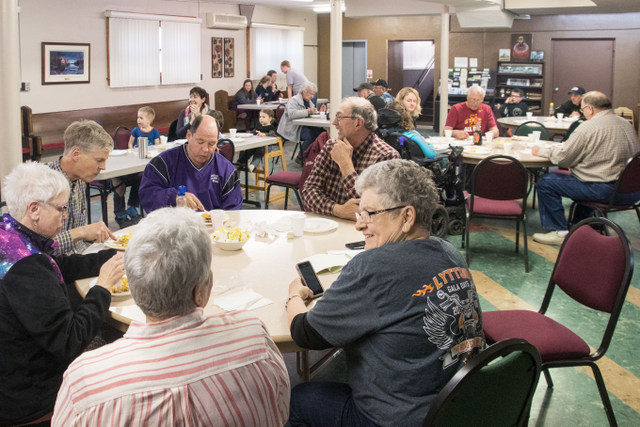
Doing Good, Eating Good at Lytton Town Night
What’s the glue that keeps a community connected? Around Lytton, Iowa, it’s food and fun at Lytton Town Night–and the homemade pie, of course.
While Lytton, Iowa, celebrates Gala Days each year during Memorial Day weekend, planning and fundraising for this beloved 100+ year tradition starts months earlier. In fact, a key part of the process starts in that most iconic of all small-town gathering places—the church basement.
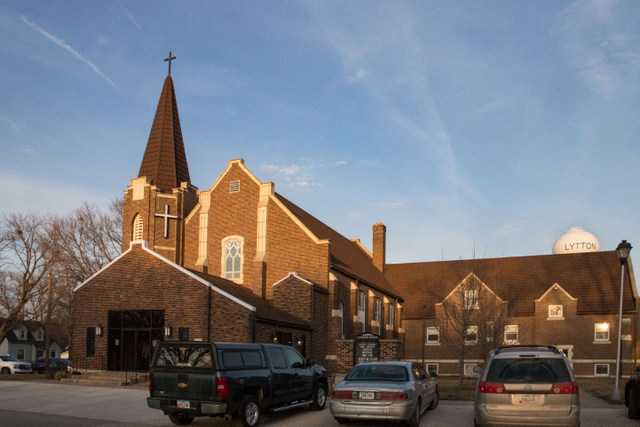
Emanuel-St John Lutheran Church in Lytton, Iowa, hosts Lytton Town Night meals throughout the winter.
The basement dining area at Emanuel-St John Lutheran Church, whose congregation has roots dating back to 1883, provides a convenient setting for Lytton Town Night, which is held each Thursday evening from mid-January through March. Each Town Night offers a unique opportunity for the community to come together for free-will-donation meal to raise money for various causes and organizations, including Gala Days.
“Town Night is great, because there are a lot of fabulous cooks around Lytton,” said Nelda Bartels, a lifelong Lytton-area resident who often volunteers at Town Night.
As word of Town Night has spread through the years, guests come not only from Lytton, but Lake City, Sac City, Rockwell City and beyond. It’s not uncommon to serve a few hundred people at each meal.
“It’s like one big family when everyone gets together,” said Wendy Miller with the Lytton Chamber of Commerce.
Lytton Town Night includes groups like the Gala Days volunteers, the South Central Calhoun FFA chapter, 4-H clubs, civic groups and individuals raising money for worthy causes, including overseas mission trips. The Lytton Chamber of Commerce coordinates the schedule for Town Night, which allows eight to 10 different groups and individuals to host a Town Night meal during the winter, complete with home-cooked food. Some groups serve a selection of pasta casseroles, while others like the local FFA members serve pancakes and sausage links.
“I like the food, because it’s all good,” said Randy Souder, a Lytton-area farmer. “It’s also affordable, so everyone can come.”
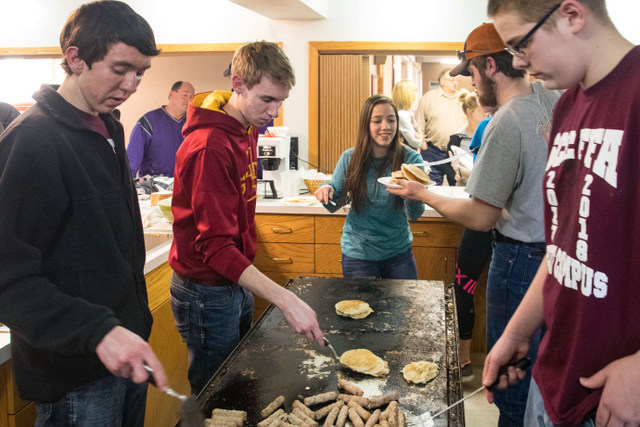
Members of the South Central Calhoun FFA chapter cooked pancakes and sausage during a Lytton Town Night fundraiser.
While no one is quite sure when Lytton Town Night started, it has been around since at least 1980, according to local-time residents. “It’s such a fun event, because you get to visit with friends and neighbors you don’t always see,” said Marlene Glasnapp, who lives with her husband, Roger, on a farm south of Lytton and is known as one of the best pie bakers in the area.
Each Town Night event is promoted through the Lytton Town Crier and on social media through Facebook. Each meal runs from 5 p.m. to 7 p.m. each Thursday evening during the winter. The popular gatherings attract people of all ages, from babies to grandparents.
Some groups, like the Gala Days volunteers, serve a lunch and a dinner meal when it’s their turn to host Town Night. “We usually have casseroles and homemade pie,” Bartels said. “The homemade pie is the kicker, because it’s always a hit.”
When the meal is done, the fellowship continues in downtown Lytton at the 1950s-era American Legion hall for bingo. “Town Night bingo has been called Lytton’s winter sport,” Bartels said.
The evening of bingo lasts about an hour and a half, and participants can play as many cards as they want. Two cards cost $3, and the proceeds support the American Legion.
Town Night isn’t just a fun evening, added Brian Lantz, an ag instructor at South Central Calhoun High School who advises the local FFA chapter. “It’s a local tradition, plus the kids learn how to work with the public when it’s their turn to cook and serve the meal.”
Keeping the Town Night tradition alive is important to residents of Lytton, which has a population of 302 residents. “Every year we wonder if we’ll be able have Town Night again,” Miller said. “We’re going to keep it going as a long as we can.”

Creamy Chicken Pasta Casserole
Creamy Chicken Casserole
This simple, hearty dish from Nelda Bartels of Lytton was served at the Gala Days fundraiser at Lytton Town Night in March 2018.
3 boneless, skinless chicken breasts, cooked and shredded
1 teaspoon garlic powder
1 tablespoon olive oil
1 10.75-ounce can cream of chicken soup
1 10.75-ounce can cream of mushroom soup
1 cup milk
1 bag (2 cups) shredded Cheddar cheese
1 / 2 teaspoon ground black pepper
1-pound box elbow macaroni (cooked according to package directions)
1 1 / 2 cups panko bread crumbs or regular bread crumbs
Preheat oven to 350 degrees. Cook chicken with garlic powder. (Nelda uses a programmable pressure cooker and adds a couple cups of chicken broth.) Drizzle with olive oil. When done, shred chicken with a fork, and save the juice.
Combine the two cream soups, milk, cheese, cooked chicken, broth from chicken and pepper. (If desired, add some sour cream or cream cheese into the mixture for extra flavor and creaminess.) Add cooked macaroni. Stir the mixture and pour into a 9-inch by 13-inch casserole pan.
Top casserole with panko breadcrumbs. Bake at 350 degrees for 20 to 25 minutes. Brown panko topping under broiler on low for 3 to 5 minutes. Watch closely, since the breadcrumbs can burn quickly.
Bowtie Lasagna Casserole
This tasty recipe comes from Nelda Bartels of Lytton.
1 jar spaghetti sauce
1 to 1.5 pounds ground beef
1 package bowtie pasta noodles (cooked according to package directions)
1 small carton cottage cheese
1 8-ounce package cream cheese
1 small carton sour cream
Mozzarella cheese
Preheat oven to 350 degrees. Brown hamburger; mix with spaghetti sauce. Pour sauce on bottom of 9-inch by 13-inch baking pan. Combine hamburger and bowtie pasta. Combine cottage cheese, cream cheese, and sour cream. Add to hamburger/pasta mix; pour in baking pan. Top with mozzarella cheese.
Bake at 350 degrees for 45 minutes to 1 hour.
Poppy Seed Chicken
This recipe comes from Susan Albright of Lytton.
4 chicken breasts, cooked and cubed
1 carton (16 ounces) sour cream
1 10.75-ounce can cream of chicken soup
Very small handful of spaghetti, broken into pieces and cooked (Susan Albright uses three fourths of a box of angel hair pasta)
1 stick butter
40 Ritz crackers, crushed
1 / 2 tablespoon poppy seeds
Preheat oven to 350 degrees. After cooking chicken, season to taste with garlic salt and onion. Combine sour cream and soup. Add cubed chicken and cooked spaghetti to mixture. Add salt, to taste.
Pour mixture into greased, 9-inch by 13-inch baking dish.
In a separate bowl, melt butter; add crushed crackers and poppy seeds. Sprinkle cracker mixture on top of casserole. Bake for 20 minutes.
Pie Crust
For decades, Marlene Glasnapp of rural Lytton has relied on this recipe, which yields approximately 6 crusts per batch.
5 cups flour
1 teaspoon salt
1 pound lard
1 cup water
Combine flour and salt. Cut lard into the flour mixture. Add water, a little at a time, mixing quickly and evenly until dough just holds together in a ball. Divide dough for six crusts. (The crusts can be frozen for later use, and Marlene often rolls hers out before freezing.)
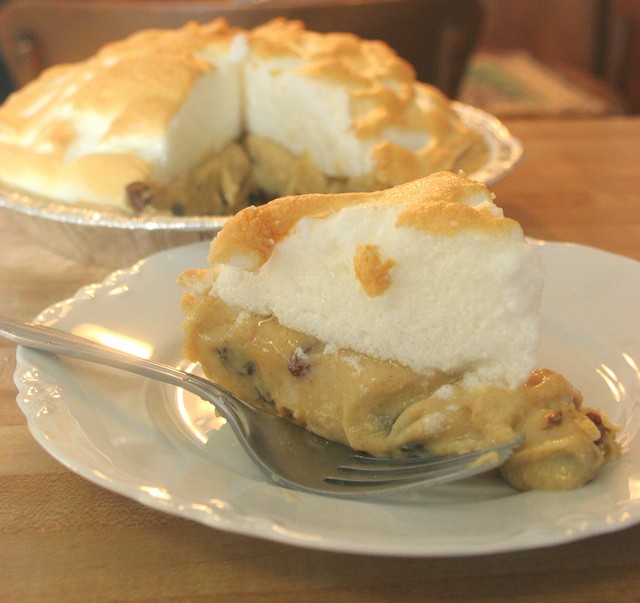
Raisin Cream Pie
Marlene Glasnapp’s raisin cream pie is always a hit wherever it’s served.
1 cup granulated sugar
3 tablespoons flour
1 / 2 teaspoon salt
1 teaspoon cinnamon
2 cups half-and-half
3-4 egg yolks (depends on the size of the eggs)
1 cup raisins
Mix dry ingredients with 1 / 2 cup of half-and-half, and set aside. Whisk egg yolks, and combine remaining half-and-half with the yolks. Add this mixture to the pie filling mix you set aside earlier.
Add raisins to the mixture and stir over medium heat until thick. Cool slightly. Pour in baked pie shell and top with meringue.
Meringue
1 tablespoon cornstarch
1 / 2 cup plus 1 tablespoon water
3 to 4 egg whites (depending on the size of the eggs)
3 to 4 tablespoons granulated sugar
Dissolve 1 tablespoon of cornstarch in 1 tablespoon of water. Boil 1 / 2 cup water and add to cornstarch mixture. Cook until clear. (This can be done in the microwave.) Beat egg whites and gradually add sugar. Add cooled cornstarch mixture and beat to proper consistency. Spread meringue over top of pie, sealing to the edge. Bake pie at 350 degrees Fahrenheit until meringue has browned.
Note from Darcy: I first wrote this piece in 2018 for Farm News.
Want more?
Thanks for stopping by. I invite you to read more of my blog posts if you value intriguing Iowa stories and history, along with Iowa food, agriculture updates, recipes and tips to make you a better communicator.
If you like what you see and want to be notified when I post new stories, be sure to click on the “subscribe to blog updates/newsletter” button at the top of this page, or click here. Feel free to share this with friends and colleagues who might be interested, too.
Also, if you or someone you know could use my writing services (I’m not only Iowa’s storyteller, but a professionally-trained journalist with 20 years of experience), let’s talk. I work with businesses and organizations within Iowa and across the country to unleash the power of great storytelling to define their brand and connect with their audience through clear, compelling blog posts, articles, news releases, feature stories, newsletter articles, social media, video scripts, and photography. Learn more at www.darcymaulsby.com, or e-mail me at yettergirl@yahoo.com.
If you’re hungry for more stories of Iowa history, check out my top-selling “Culinary History of Iowa: Sweet Corn, Pork Tenderloins, Maid-Rites and More” book from The History Press. Also take a look at my latest book, “Dallas County,” and my Calhoun County” book from Arcadia Publishing. Both are filled with vintage photos and compelling stories that showcase he history of small-town and rural Iowa. Order your signed copies today! Iowa postcards are available in my online store, too.
Let’s stay in touch. I’m at darcy@darcymaulsby.com, and yettergirl@yahoo.com.
Talk to you soon!
Darcy
@Copyright 2018 Darcy Maulsby & Co. Blog posts may only be reprinted with permission from Darcy Maulsby.
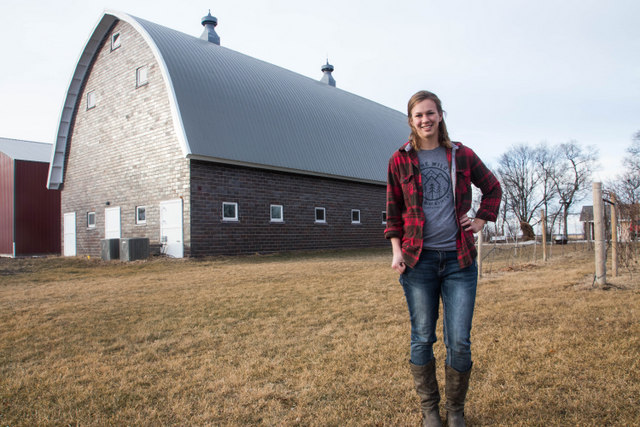
Events Spark Stories That Help Backcountry Winery Grow in Iowa
Ask Amber Gable about the back story behind Backcountry Winery at her family’s home east of Stratford, and her answer is straightforward. “It’s a hobby out of control.”
That hobby has taken Gable and her husband, Preston, on dynamic journey that has led to the creation of a small business that’s helping spur economic development in rural Iowa. At the heart of it all is a century-old barn that’s central to the story, offering an attractive venue for gatherings, celebrations, music concerts and more.
“This barn is such a unique building,” said Amber Gable, 27, who grew up on a farm near Sibley. “There’s so much history here, including original interior boards that have Stratford Grain and Supply stamped on them.”

Beyond the tasting room on the main floor, the barn loft holds 150 people.
Guests who come to Backcountry Winery for bridal showers, wedding receptions, class reunions and other celebrations enjoy exploring this rural heritage. So do the visitors who stop by for Backcountry Winery’s live music events.
“When we’re open on Saturday afternoons without a special event like live music, we tend to have smaller crowds,” Gable said. “Events help create experiences that people seek out.”
Events of all types have become an increasingly important part of running a successful winery, noted Mike White, a viticulture specialist for Iowa State University Extension. “More wineries are realizing that there’s big potential in event centers, and many are going this way.”
Putting down roots in Hamilton County
For many guests, part of the experience involves learning the story of the winery. In the case of Backcountry Winery, that story began with Preston Gable’s long-time interest in home winemaking.
“We’d talk about how we might open a winery someday,” said Amber Gable, whose husband is a fellow northwest Iowa native from Hartley.
“Someday” seemed far off, however, when the high school sweethearts started their careers in Ames following their graduation from Iowa State University (ISU). Amber Gable became a landscape designer for an engineering firm, while her husband worked in biofuels research at ISU.
When the couple began looking for an affordable acreage in central Iowa where they could establish a home, start a family and maybe operate a winery eventually, the process became frustrating at times. “We actively looked for about a year and often came up with nothing,” Amber Gable said. “There were some tears along the way.”
Things turned around in 2014, though, when the young couple found an acreage with a house and barn northeast of Stratford. “We really needed a fixer-upper, and this place needed a family to put down roots,” Amber Gable said.
After the couple purchased the property in August 2014, they began remodeling the barn within a few months and exploring its history. The abstract for the property goes back to 1920, when the current home on the acreage was built by Alfred Erickson. “We know the barn pre-dates 1920, although we don’t know exactly when it was built,” Amber Gable said.
While the barn is structurally sound, time had taken a toll on some parts of the building. “We poured a new concrete floor and replaced the entire hayloft floor,” said Amber Gable, who noted that the barn once housed cattle.
After months of work, the Gables opened Backcountry Winery in May 2016. “The barn is still a work in progress, but it has allowed us to open our winery sooner than we anticipated,” said Amber Gable, who appreciates the opportunity to run a home-based business, especially now that she and her husband are raising their 1-year-old son, Ivan.
Word-of-mouth marketing, Backcountry Winery’s website and a Facebook page have helped the couple’s business grow. While Backcountry Winery hosted one wedding in 2016, this grew to five weddings in 2017 and has increased to seven weddings slated for 2018.
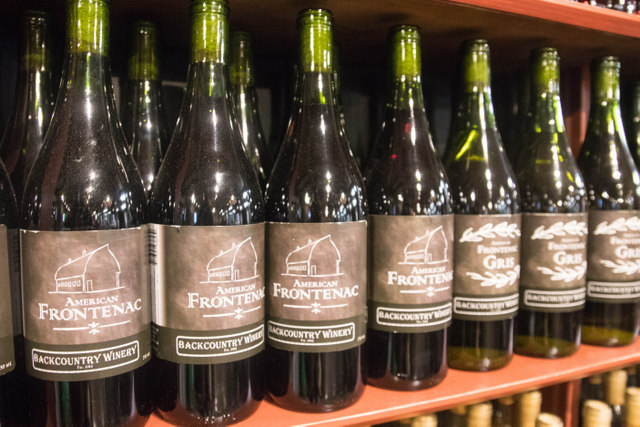
At Backcountry Winery, the Gables grow six varieties of wine grapes. They make 12 different wines, including strawberry, raspberry, cherry and apple wines, and plan to expand to 14 wines soon.
The Gables have invested in an expansion near the barn to accommodate these events. A connecting space on the west side of the barn will include a room when brides can get ready for their wedding. This connecting space is attached to a 60-foot by 90-foot addition that will provide additional production space, storage space and office space for the winery.
This infrastructure is just one part of Backcountry Winery’s recent expansions. While the Gables maintain a vineyard on the east side of the barn, the couple also began leasing an established, 4-acre vineyard near Webster City in the spring of 2017.
“It’s exciting to raise more of our own grapes so we can produce estate wines, which are made from our own crop,” said Amber Gable, who is a member of the Iowa Wine Growers Association. “There’s a great deal of pride in that.”
Wine wins big at Iowa State Fair
This pride is reflected in the large, silver trophy that graces the barn at Backcountry Winery. When the Gables competed in the commercial wine competition at the 2017 Iowa State Fair, the judges selected Vignoles from Backcountry Winery for the top honor, the Governor’s Cup. Vignoles is a semi-dry white wine that boasts crisp flavors of tropical and citrus fruits and a clean finish.
Vignoles is just one of the wines available from Backcountry Winery, where the Gables grow six varieties of wine grapes. They make 12 different wines, including strawberry, raspberry, cherry and apple wines, and plan to expand to 14 wines soon.
Backcountry Winery’s products can be purchased at the winery or through the approximately 25 retailers in Hamilton County and central, northern and northwest Iowa that partner with Backcountry Winery.
Raising specialty crops like wine grapes and offering Iowa wines offer unique opportunities to boost economic development in rural Iowa, Amber Gable said. “When visitors come to our winery, they not only buy wine, but they buy fuel at the convenience store in Stratford, which is owned by the local co-op, and they can go to Stanhope to get a burger. It’s rewarding to promote the whole Hamilton County experience.”
The Gables hope to attract more guests to the area by offering more live music this summer at the winery. This builds on the success of the three performances offered in 2016 and the 10 shows offered in 2017. The 2018 concerts, which range from country to classic rock, cost $5 for admission and will be held on certain Saturdays from 6 p.m. to 8 p.m. in the barn.
“Visiting a winery is all about the experience,” Amber Gable said. “We enjoy creating these memorable experiences, meeting people from across Iowa and beyond and promoting rural Iowa.”

When the Gables competed in the commercial wine competition at the 2017 Iowa State Fair, the judges selected Vignoles from Backcountry Winery for the top honor, the Governor’s Cup. Vignoles is a semi-dry white wine that boasts crisp flavors of tropical and citrus fruits and a clean finish.
Iowa’s Wine Industry, By the Numbers
Data from the Iowa Wine Growers Association (IWGA) shows that Iowa has:
• 103 wineries
• 267 vineyards
• 1,300 acres of grapes
• 8 wine trails
• 40+ cold-climate grapes grown
• $420 million of economic impact in 2012
• 2,600 full-time jobs
• 358,000 wine related tourists per year
On average, the typical Iowa winery produces approximately 3,000 gallons of wine annually. The Iowa native wine industry helps promote and establish additional activity in the state, including lodging, food, travel, gifts, agri-tourism, event centers, festivals, music, art and a host of service industries.
“By our estimation, based on direct feedback from the wineries we surveyed, there was over $2.1 million in revenue generated from these wine-related events and facilities,” according to the 2012 “Economic Impact of Iowa Wine and Wine Grapes” report produced by Frank, Rimerman + Co, LLP.
In order for the industry to keep growing and attracting new visitors, wineries not only need to continue focusing on improving wine quality, but consider expanding into more wine-related events like private parties, weddings and festivals held on winery properties, according to the report.
- I originally wrote this story for the Progress section of Farm News, Ft. Dodge, Iowa in February 2018.
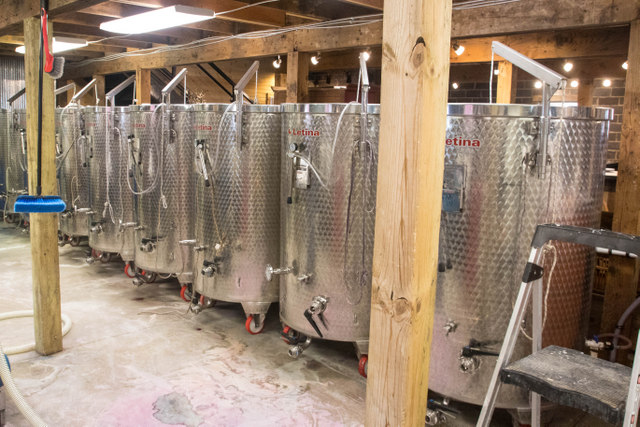
Backcountry Winery’s fermenting equipment is housed in a Hamilton County, Iowa, barn that’s approximately 100 years old.
Want more?
Thanks for stopping by. I invite you to read more of my blog posts if you value intriguing Iowa stories and history, along with Iowa food, agriculture updates, recipes and tips to make you a better communicator.
If you like what you see and want to be notified when I post new stories, be sure to click on the “subscribe to blog updates/newsletter” button at the top of this page, or click here. Feel free to share this with friends and colleagues who might be interested, too.
Also, if you or someone you know could use my writing services (I’m not only Iowa’s storyteller, but a professionally-trained journalist with 20 years of experience), let’s talk. I work with businesses and organizations within Iowa and across the country to unleash the power of great storytelling to define their brand and connect with their audience through clear, compelling blog posts, articles, news releases, feature stories, newsletter articles, social media, video scripts, and photography. Learn more at www.darcymaulsby.com, or e-mail me at yettergirl@yahoo.com.
If you’re hungry for more stories of Iowa history, check out my top-selling “Culinary History of Iowa: Sweet Corn, Pork Tenderloins, Maid-Rites and More” book from The History Press. Also take a look at my latest book, “Dallas County,” and my Calhoun County” book from Arcadia Publishing. Both are filled with vintage photos and compelling stories that showcase he history of small-town and rural Iowa. Order your signed copies today! Iowa postcards are available in my online store, too.
Let’s stay in touch. I’m at darcy@darcymaulsby.com, and yettergirl@yahoo.com.
Talk to you soon!
Darcy
@Copyright 2018 Darcy Maulsby & Co. Blog posts may only be reprinted with permission from Darcy Maulsby.
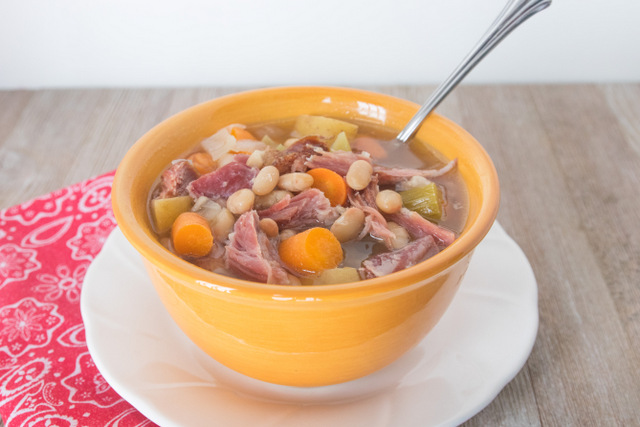
In Praise of Ham and Bean Soup
I’ve never understood why a smoky, delicious ham and bean soup is so hard to find. Heck, just a lackluster, ho-hum ham and bean soup is often hard to find.
I always figured no one knows more about ham and bean soup than Iowa farm cooks, especially when those who grew up on a hog farm like I did. Pork galore in all its forms was a staple on our family’s dinner table for generations. Plus, soup night was always Sunday night at our farm—and it still is. What a treat when ham and bean soup is on the menu!
With its rich broth and smoky undertones, there’s nothing like a hearty ham and bean soup to chase away the winter chill (or bitter cold, depending on what Mother Nature throws at us.) As I’ve refined my own recipe through the years, I’ve come to three conclusions:
1. You MUST have a thick, smoked ham hock (also known as a ham shank) to make the magic. No cubes of cured ham are going to cut it, if you want maximum flavor. This is a heavy-duty, low-and-slow kind of job for a tough, smoky ham shank.
2. We’re blessed to have many great meat lockers in Iowa, a reflection of our thriving livestock industry, where I can get fabulous smoked ham hocks. One of my favorite suppliers? Lewright Meats in Eagle Grove, which has been serving northern Iowa since 1936.
3. Adding diced potatoes is a good thing for ham and bean soup. I like to add oomph to my cooking, and how can you go wrong with extra veggies? Adding potatoes might be a bit non-traditional for ham and bean soup, but that’s how I roll.
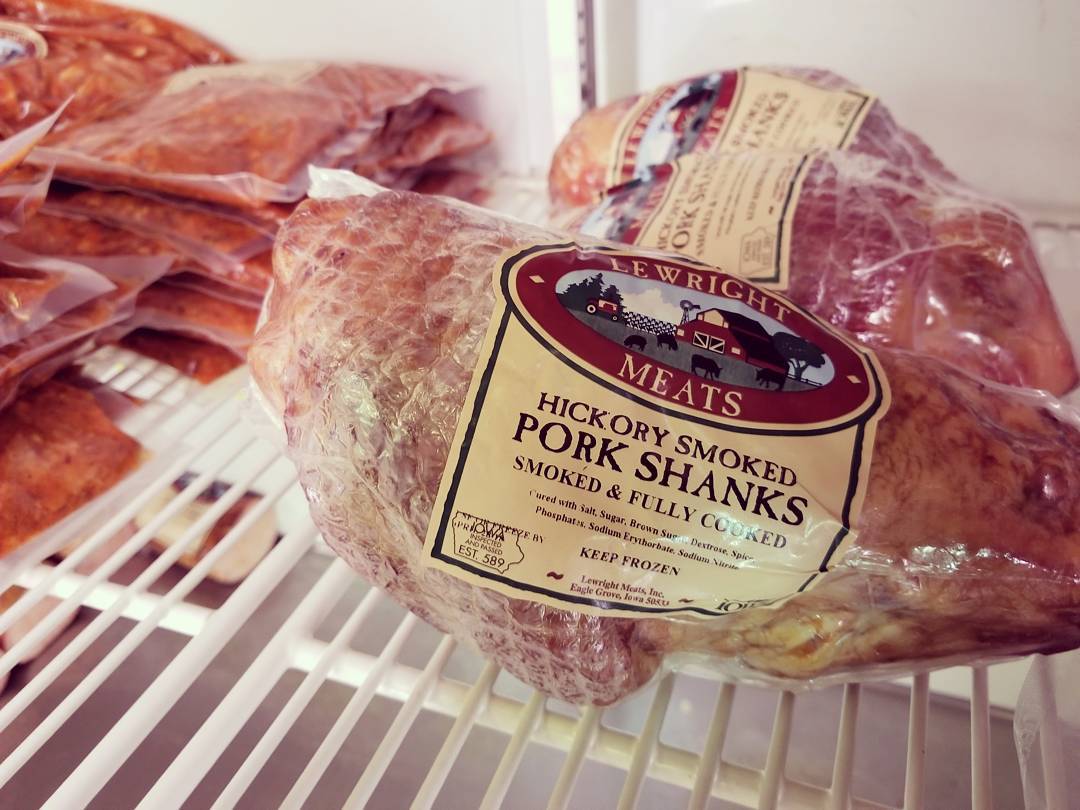
This smoked ham hock from Lewright Meats in Eagle Grove is the key to a great ham and bean soup.
The thing about ham and bean soup is that it can be a palette you fine-tune to your own tastes. Don’t like garlic? Leave it out. Want more onions in the mix? Add another one. (As my dear neighbor and farm cook extraordinaire Alice Ann Dial taught me, onions are a cheap way to add lots of flavor.)
The story behind Congress and Bean Soup
“Thunderation,” roared Speaker of the House Joe Cannon of Illinois. “I had my mouth set for bean soup! From now on, hot or cold, rain, snow, or shine, I want it on the menu every day.”
Obviously, ham and bean soup isn’t just a farm favorite. Turns out it has a rich history in the kitchens of Washington, D.C., too.
While ham and bean soup was a common item on the U.S. House of Representatives’ menu before the turn of the 20th century, it became a permanent fixture in the institution when Speaker Joe Cannon of Illinois discovered that his favorite meal had not been prepared by the kitchen staff on a hot, summer day in 1904.
Cannon, who was the namesake of the Cannon House Office Building, served in the U.S. House for 46 years. Dismayed by that egregious menu omission in 1904, the Speaker directed that bean soup be served in the House every day, regardless of the weather.
More than a century after Speaker Cannon’s decree, bean soup remains on the menu in the House Restaurant, making it one of the more longstanding and famous traditions in the House.
Members of the U.S. House aren’t the only fans of ham and bean soup. It’s also on the menu in the Senate’s restaurant every day. There are several stories about the origin of that mandate, but none has been corroborated.
According to one story, the Senate’s bean soup tradition began early in the 20th-century at the request of Senator Fred Dubois of Idaho. Another story attributes the request to Senator Knute Nelson of Minnesota, who expressed his fondness for the soup in 1903.
The recipe attributed to Dubois includes mashed potatoes and makes a 5-gallon batch. The recipe served in the Senate today does not include mashed potatoes, but does include a braised onion. Click here to check out both Senate recipes.
No matter how you like your ham and bean soup, here’s my take on this American classic. Enjoy, and let me know what you think.
Darcy’s Hearty Ham and Bean Soup
1 smoked ham hock (also called a smoked ham shank)—the meatier, the better
1 48-ounce jar great northern beans (I don’t drain and rinse the beans—I add it all)
3 stalks celery, diced
3 carrots, peeled and sliced
3 to 4 medium potatoes, diced (I prefer Yukon Golds)
1 large onion, chopped
1 tablespoon garlic, minced
1 teaspoon fresh-ground pepper
Water or chicken stock
Salt, to taste
Place ham hock in slow cooker. Add beans, celery, carrots, potatoes, onion, garlic and pepper. Cover with water or chicken stock until slow cooker is full. (If using water rather than chicken stock, I often add 2 or 3 teaspoons of Better Than Bouillon chicken soup base to add more flavor.)
Cook on low for 8 to 10 hours. (I often prepare the soup in the evening and let it cook overnight.) Remove ham hock, allow it to cool, and remove ham from the bone. Add ham back to the soup. Taste the soup to see if it needs salt. Add salt, if desired. (Some ham hocks add enough flavor to the broth that no salt is needed.)
• Note: homemade soup often develops more flavor if you let it sit in the refrigerator overnight and serve the soup the next day. This Hearty Ham and Bean Soup is so good, though, that I understand if you dig in right away!
P.S. Thanks for joining me. I’m glad you’re here.
Want more?
Thanks for stopping by. I invite you to read more of my blog posts if you value intriguing Iowa stories and history, along with Iowa food, agriculture updates, recipes and tips to make you a better communicator.
If you like what you see and want to be notified when I post new stories, be sure to click on the “subscribe to blog updates/newsletter” button at the top of this page, or click here. Feel free to share this with friends and colleagues who might be interested, too.
Also, if you or someone you know could use my writing services (I’m not only Iowa’s storyteller, but a professionally-trained journalist with 20 years of experience), let’s talk. I work with businesses and organizations within Iowa and across the country to unleash the power of great storytelling to define their brand and connect with their audience through clear, compelling blog posts, articles, news releases, feature stories, newsletter articles, social media, video scripts, and photography. Learn more at www.darcymaulsby.com, or e-mail me at yettergirl@yahoo.com.
If you’re hungry for more stories of Iowa history, check out my top-selling “Culinary History of Iowa: Sweet Corn, Pork Tenderloins, Maid-Rites and More” book from The History Press. Also take a look at my latest book, “Dallas County,” and my Calhoun County” book from Arcadia Publishing. Both are filled with vintage photos and compelling stories that showcase he history of small-town and rural Iowa. Order your signed copies today! Iowa postcards are available in my online store, too.
Let’s stay in touch. I’m at darcy@darcymaulsby.com, and yettergirl@yahoo.com.
Talk to you soon!
Darcy
@Copyright 2018 Darcy Maulsby & Co.
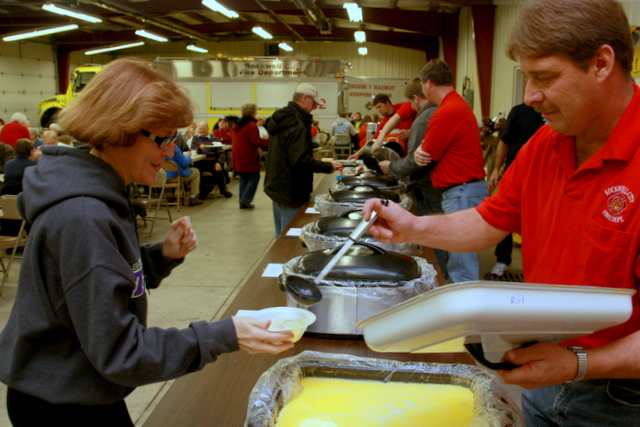
Mmm, Mmm Good: Soup’s on at the Rockwell City Fire Department
While soup is often considered little more than a prelude to something bigger, that’s not the case at the Rockwell City Fire Department. Throughout the winter, roasters filled with homemade chili, cheesy chicken noodle soup and other favorites make the fire station one of the hottest destinations in town.
“We typically serve 300 to 400 people at each supper,” said Duane Murley, a well-known farm broadcaster who has served on the Rockwell City Fire Department for 21 years. “Many times we have a line out the door.”
Murley and his fellow firefighter, Phil Hammen, co-chair the soup suppers, which are held the second Sunday of November, December, January and February from 4 p.m. to 6:30 p.m. at the fire station in Rockwell City. There’s no set fee to attend the soup suppers, which are supported by free-will donations.
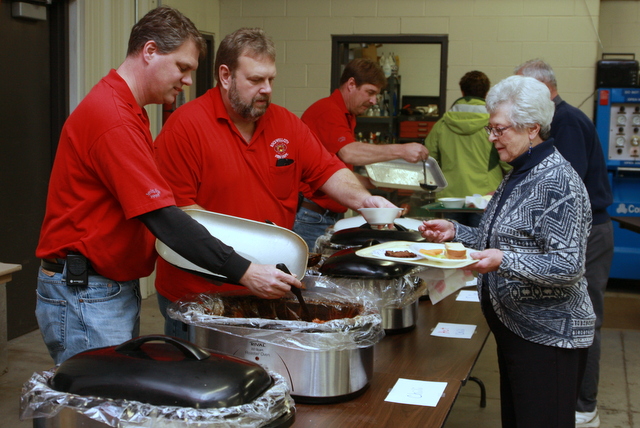
The volunteer firefighters serve two kinds of chili, cheesy chicken noodle soup, 8-Can Soup and more.
“This isn’t so much a money maker as it’s a way for the community to come together,” said Murley, who noted at the soup suppers have been held each winter for nearly seven years.
Many of the guests come from Rockwell City, Lake City, Manson and Twin Lakes. “I like to stop by and help support another local fire department,” said Josh Waller, who serves on the Manson Fire Department and the Calhoun County Farm Bureau board.
While each soup supper includes standard items such as potato soup and chili, the firefighters also mix things up with cheeseburger soup and other options. Each December, local supporters donate ingredients for the oyster stew, which is always a big hit. “They always have lots of good soup here and lots of variety,” said Toni Kerns of Rockwell City.
The firefighters often begin making their soups on Thursday or Friday before the Sunday soup supper. “The key to a good soup is to give it enough time to develop plenty of flavor,” said Phil Hammen, who co-chairs the soup suppers.
Perhaps the simplest—yet most talked-about—menu items are the famous lettuce sandwiches. These are just what they sound like—leaves of lettuce sandwiched between two slices of bread spread with mayonnaise or butter.
“These started as a joke,” said Murley, who recalled his mother-in-law’s stories of eating lettuce sandwiches during her school days at Jolley. “Now people look forward to them so much that we often use seven pounds or more of lettuce during our soup suppers.”
From the lettuce sandwiches to the homemade soups, the firefighters want guests to relax and reconnect with friends and family. “It’s not just about the food,” Murley said. “It’s about being part of the community.”
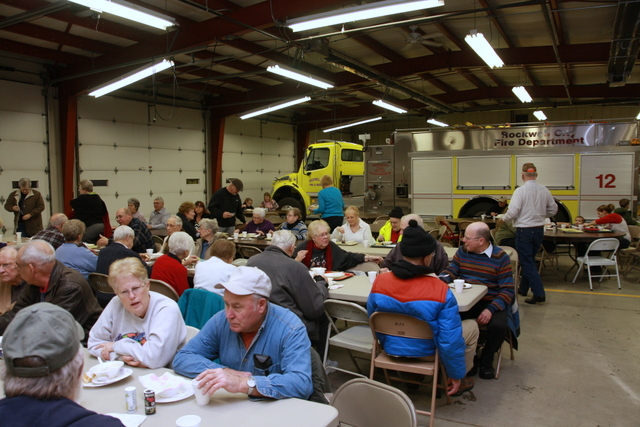
Cold Iowa winter nights don’t deter locals from enjoying the monthly soup suppers at the Rockwell City Fire Department.
8-Can Soup
People often ask if this flavorful soup really contains eight cans of ingredients. Yes it does, says Shane Voith, who has served as Rockwell City’s fire chief, who often multiplies this recipe by five to make this hearty soup for the soup supper.
1 can Hormel chili with beans
1 can Hormel chili, no beans
1 can sliced potatoes, undrained
1 can cut green beans, undrained
1 can whole-kernel corn, undrained
1 can mixed vegetables, undrained
1 can vegetable beef stew
1 can steak and potato soup
1 packet of powdered ranch dressing
Combine all ingredients in a large slow cooker, kettle or roaster. Cook on low all day, or for 2 to 3 hours on high to get the soup hot.
Sweet Chili
Jonathan Wetter, a Rockwell City volunteer firefighter, got this recipe from a friend. It’s reminiscent of both a sweet chili and calico beans.
Half a pound of bacon, cooked and diced
1 pound ground beef, browned
1 can lima beans, drained
1 can butter beans, drained
1 can kidney beans, undrained
1 can pork-and-beans, undrained
1 small onion, chopped
16-ounce can crushed pineapple
1 tablespoon mustard
4 tablespoons molasses
2 tablespoons vinegar
1 / 2 cup brown sugar
1 teaspoon Worcestershire sauce
1 / 2 cup ketchup
Combine all ingredients. Cook on low in a slow cooker or roaster for a few hours until hot.
Firehouse Chili
Duane Murley, co-chair of the fire department’s soup suppers, often makes three roasters of this chili, including one batch with hot peppers for a spicier chili.
7 pounds hamburger, browned
2 gallons Bush’s chili beans
2 gallons diced tomatoes
1 gallon tomato juice
Hot peppers, diced—optional
Cookies Flavor Enhancer, to taste
Chili powder, to taste
Combine all ingredients in a kettle, slow cooker or roaster. Cook on high for several hours or on low all day.
Potato Soup
Phil Hammen, co-chair the fire department’s soup suppers, specializes in this filling Potato Soup. This recipe makes enough to fill one roaster.
15 pounds potatoes, diced and boiled until tender
3 onions, diced
3 ham steaks, cubed
1 1 / 2 gallons 2% milk
2 sticks butter
Combine all ingredients in roaster. Cook until soup is heated through.
Cheesy Chicken Noodle Soup
This perennially popular soup is prepared by firefighter Kyle Welander of Rockwell City. When he cooks for the soup suppers, he boils eight whole chickens, removes the meat from the bones and saves the liquid to make homemade chicken broth.
1/4 cup butter, melted
1/4 cup flour
3 cups chicken broth
1 cup milk
2 cups Velveeta processed cheese, cubed
2 cups egg noodles, cooked
2 cups cooked, diced chicken
Melt butter in a large saucepan and add flour. Add chicken broth and milk. Cook, stirring occasionally on medium-high heat, until the mixture starts to bubble and thicken. Add cubed Velveeta cheese, and stir until melted. Pour mixture into larger pan or kettle. Add 2 cups of cooked egg noodles and 2 cups cooked, diced chicken. Cook on low. To fill a roaster, multiply this recipe by eight.
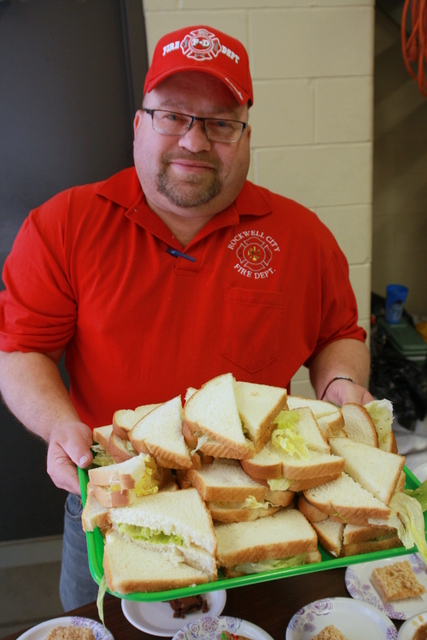
Calhoun County’s Famous Lettuce Sandwiches
Sliced bread
Mayonnaise or butter
Lettuce
Spread slices of bread with mayonnaise or butter. Top the bottom slice with a few leaves of lettuce. Add top slice of bread to complete the sandwich.
Lois Hensel’s Cake
Shelly Hammen of Rockwell City often makes desserts for the fire department’s soup suppers, including this incredible cake that was made famous by Lois Hensel, a long-time cake baker from Lake City. This recipe has been copied from a local cookbook.
2 packages Betty Crocker white cake mix, plus 1 1 / 2 cups from a third box of cake mix
7 / 8 cup egg whites
3 cups water
1 / 2 cup vegetable oil
1 1 / 2 teaspoons almond flavoring
1 / 2 teaspoon butter flavoring
Place cake mixes in mixer bowl. Add 2 cups of water and start mixing. Add egg whites, vegetable oil, almond flavoring, butter flavoring and remaining 1 cup of water. Continue mixing for 2-3 minutes until batter is smooth.
Line two sheet-cake pans (10.5 inches by 15.5 inches by 1 inch) with typing paper (paper may overlap). Pour half of the batter into the first pan. (This should weigh about 3.5 pounds or a bit more.) Place this pan on top oven rack. Bake 10 minutes at the recommended baking temperature on the cake mix box.
Stir the rest of the batter a bit with a spatula. Pour this batter into second cake pan. When first cake tests done (by a light touch of a finger) after about 20 minutes, remove cake from oven. Place second cake on top rack in oven. Bake until done.
Cool the first cake about 10 minutes, and run a knife around the four sides to loosen. Place a few layers of newspaper on both the cake top and on a bigger board. Holding securely, turn cake over onto the board, and peel liner paper off the cake. The brown on top of the cake will now adhere to the newspaper; peel off newspaper.
Place prepared board over cake, holding securely. Turn board and cake over, and place liner paper on cake. Place this in a plastic bag and freeze. It will be easy to trim the four sides with a serrated knife when cake is removed from the freezer.
Have icing ready. Stack four to five piece of 10.5-inch by 15-inch cardboard covered with tinfoil to hold each cake.
Lois Hensel’s Cake Icing
3 / 4 cup egg whites
4 pounds powdered sugar, divided
4 large “blobs” of Crisco shortening
1 teaspoon salt
1 / 2 cup water
1 teaspoon almond flavoring
1 / 2 teaspoon butter flavoring
1 / 2 teaspoon (or more) lemon flavoring
2 teaspoons clear vanilla
Place egg whites in mixer bowl. Add a pound of powdered sugar. Mix, and add shortening and salt. As you continue to mix, add water, remaining powdered sugar, almond flavoring, butter flavoring, lemon flavoring and clear vanilla. Don’t beat—just mix until smooth and until the right consistency is reached, scraping the sides of the bowl with a spatula. Add more powdered sugar, if needed.
This feature originally ran in Farm News.
P.S. Thanks for joining me. I’m glad you’re here.
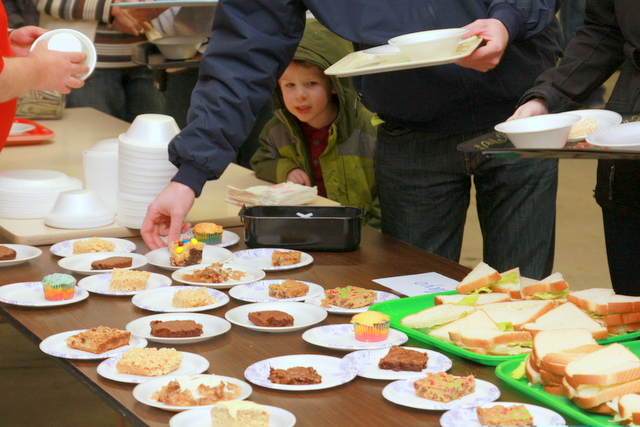
Everyone loves dessert at the soup supper.
Want more?
Thanks for stopping by. I invite you to read more of my blog posts if you value intriguing Iowa stories and history, along with Iowa food, agriculture updates, recipes and tips to make you a better communicator.
If you like what you see and want to be notified when I post new stories, be sure to click on the “subscribe to blog updates/newsletter” button at the top of this page, or click here. Feel free to share this with friends and colleagues who might be interested, too.
If you’re hungry for more stories of Iowa history, check out my top-selling “Culinary History of Iowa: Sweet Corn, Pork Tenderloins, Maid-Rites and More” book from The History Press. Also take a look at my latest book, “Dallas County,” and my Calhoun County” book from Arcadia Publishing. Both are filled with vintage photos and compelling stories that showcase he history of small-town and rural Iowa. Order your signed copies today! Iowa postcards are available in my online store, too.
Also, if you or someone you know could use my writing services (I’m not only Iowa’s storyteller, but a professionally-trained journalist with 20 years of experience), let’s talk. I work with businesses and organizations within Iowa and across the country to unleash the power of great storytelling to define their brand and connect with their audience through clear, compelling blog posts, articles, news releases, feature stories, newsletter articles, social media, video scripts, and photography. Learn more at www.darcymaulsby.com, or e-mail me at yettergirl@yahoo.com.
Let’s stay in touch. I’m at darcy@darcymaulsby.com, and yettergirl@yahoo.com.
Talk to you soon!
Darcy
@Copyright 2018 Darcy Maulsby & Co.
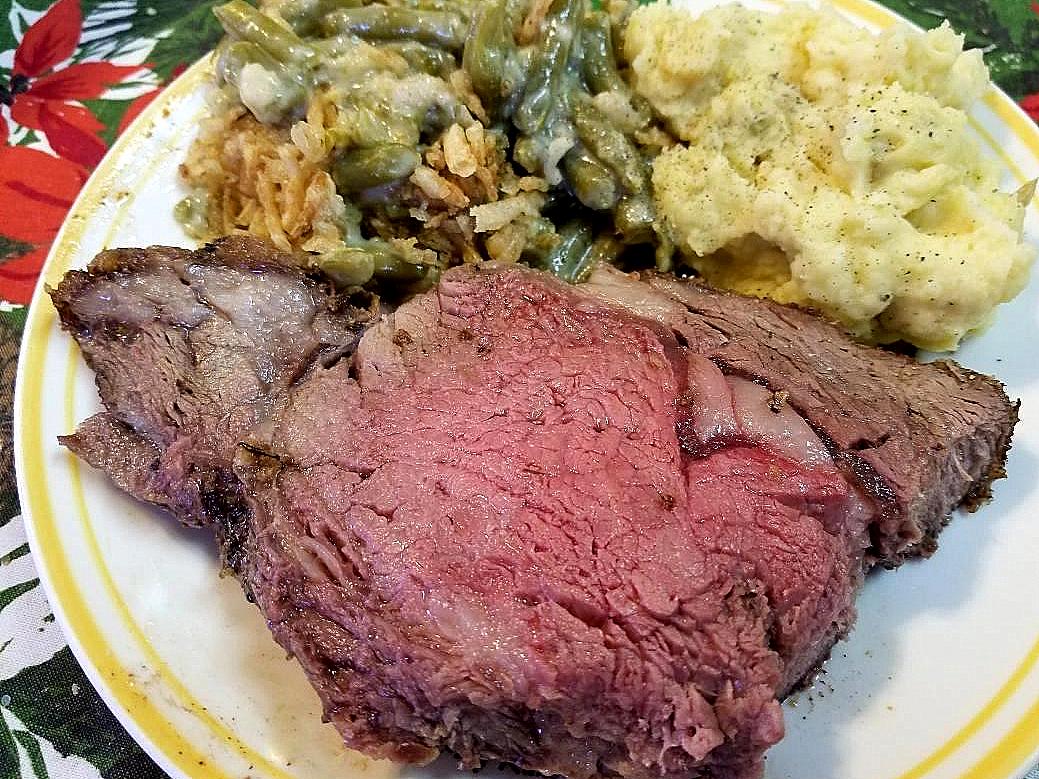
How to Cook a Perfect Prime Rib
Would you believe me if I told you restaurant-quality prime rib is one of the easiest main courses to prepare, plus you’ll look like a gourmet chef in the process? Yep, it’s true.
Take it from this Iowa farm girl. I adore the taste of prime rib. So tender, so robust, and bursting with all the flavor and juiciness that makes each bite a little trip to paradise.
When my family asked me to cook prime rib for New Year’s Day dinner, I didn’t hesitate. The prep couldn’t be simpler, and the results are simply spectacular. When you serve this delectable prime rib, your guests (possibly even the vegetarians) will be begging for more.
Let’s get cookin.’
Darcy’s Prime Rib
Select the right size roast. Allow at least 6 ounces of cooked, trimmed meat per adult. I cooked an 8-pound roast for our gathering, because I like to have leftovers. Beef and veggie soup, anyone?
Preheat the oven. Crank it up to 450 degrees Fahrenheit, and let it heat up for about 30 minutes. Also, you can remove the beef roast from the refrigerator at this time.
Gather your supplies. I recommend a metal roasting pan with a rack (like the one you might use to cook at turkey), olive oil, kosher salt, and fresh-ground pepper. Oh, and don’t forget to round up some soap and wash your hands thoroughly. We’re in the kitchen prepping food, after all!

Rachet-style pepper mill in red!
• A side note about fresh-ground pepper. I LOVE my Kuhn Rikon® high-output ratchet mill. (Check out a video here to see it in action). I appreciate the easy and speed of these wonder gadgets, plus I adore the red color of my pepper mill, since it matches my kitchen. One more thing—don’t think you’re limited to filling it with black peppercorns only. After interviewing a chef years ago about how to amp up the flavor in any dish, I took his advice and use of mix of peppercorns, including black, green, red and white, which bring a different flavor to the party.
Season the beef. Follow the K.I.S.S. method (keep it simple stupid). Prime rib roast doesn’t need a marinade or any complicated preparations, since the meat speaks for itself. Drizzle olive oil on the roast. Spread it around the roast with your hands. Next, liberally rub kosher salt and plenty of fresh-ground pepper on the meat. I don’t measure—I just go with what looks right.
If you’re thinking about using an herb mix to season the meat, I say go right ahead. I like to use this homemade herb blend that I learned to make at my dear friend Shannon Latham’s Enchanted Acres pumpkin patch near Sheffield, Iowa. I’m a big fan of the recipe here for Save Summer in a Jar Herb-Salt Mix and used it on my New Year’s prime rib–divine! Thanks to my friend Mary Lovstad of Farm Girl Cook’n in northern Iowa for all the inspiration!
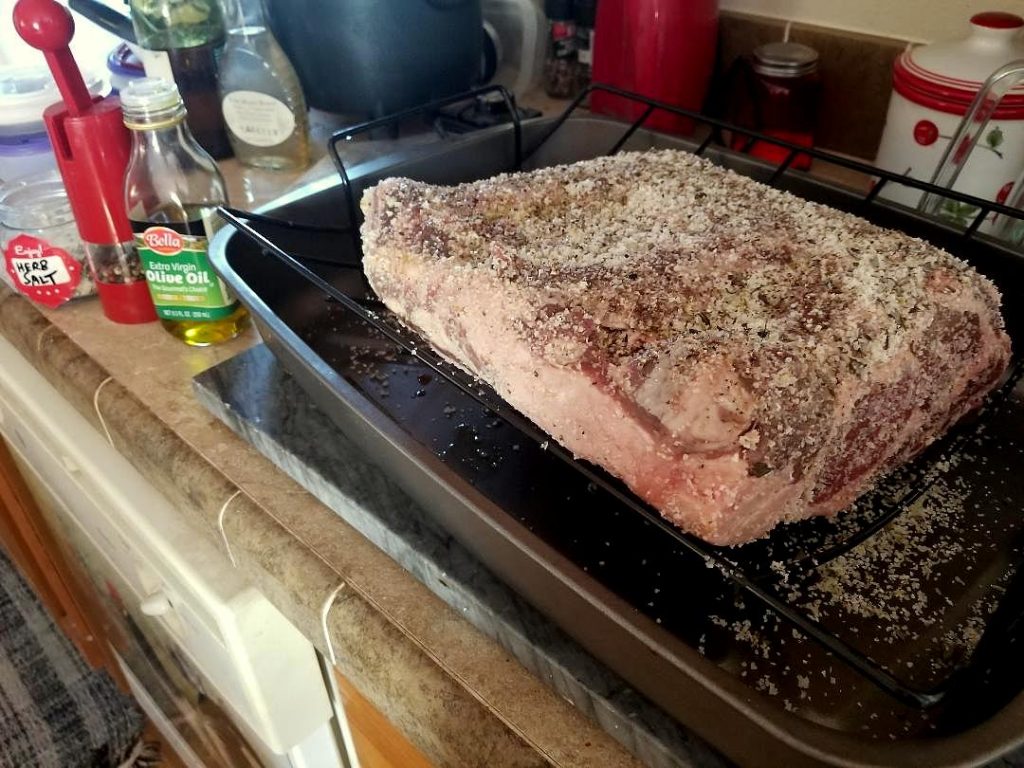
Dry rubs enhance any beef roast
Bake. Place the meat in a roasting pan that’s slightly bigger than the roast itself. I like a roasting pan and roasting rack, myself. Note–one side of the meat will have more fat on it. You want the fatty side facing up so the meat will baste itself as it cooks.
Finally, don’t add water to the pan, and don’t cover the roast. Just pop it in in the oven.
Timing is everything. How long does it take to cook a prime rib? Well, it depends. I like to start with a high temperature (450 degrees) for the first 30 minutes. Then I drop the heat to 325 degrees and allow about 13 to 15 minutes of cooking time per pound of beef.
DO NOT keep opening the oven door to check the meat. Just enjoy the tempting sizzle as the pan drippings appear during the first phase of cooking. Then savor the aromas as the beef finishes cooking over the next few hours.
A thermometer is the best way to guarantee the roast turns out exactly the way you want it. For an accurate reading, push the thermometer into the middle of the roast, making sure the tip is not touching fat or bone (or the pan). FYI–medium rare is about 130 degrees F. If that’s what you’re going for (confession–it’s my personal favorite), take the meat out of the oven when it’s around 120 degrees F. Remember that the roast’s temperature will rise at least 5 degrees after you remove it from the oven.
Let it rest. Warning—the prime rib will look incredible when you pull it out of the oven, but resist the urge to carve it right away. Let this meaty masterpiece rest for 15 or 20 minutes before carving to let the juices return to the center. Cover the roast with a “tent” of tinfoil. (If you’re at my house, be warned. My dog, Maggie the Red Heeler, is obsessed with tinfoil and will bark like a maniac when I tear a sheet of foil from the roll. Silly dog.)
With prime rib, it’s easy to satisfy everyone’s preference for doneness. The slices taken from the ends of the roast will be the most done, and the middle will be the least done.
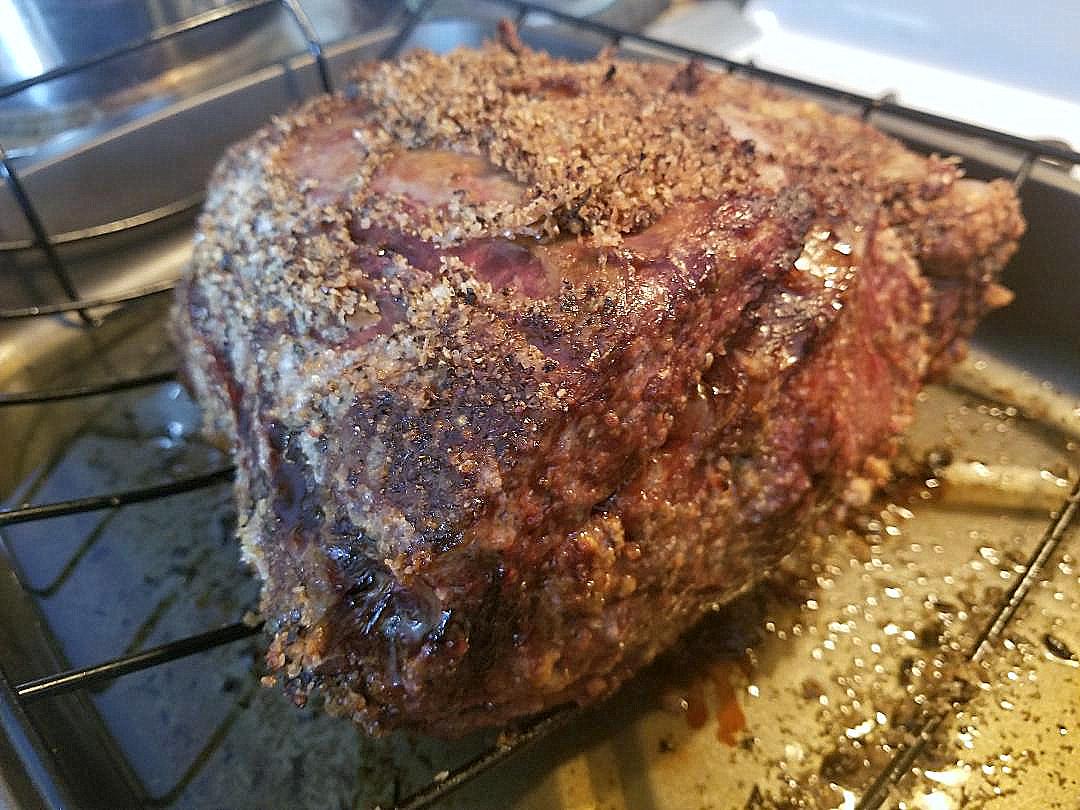
Prime rib right out of my oven
Add a little something extra. When the roast is done make sure you use the drippings in the bottom of the pan to make gravy. Then you’ll have a head-start on the most flavor-packed beef stew you can imagine.
Next time I prepare a prime rib, I’m going to try Food Network Chef Bobby Flay’s idea for Prime Rib with Thyme au Jus. Here’s what he recommends:
Place the roasting pan on top of the stove over 2 burners set on high heat. Add the wine to the pan drippings in the pan and cook over high heat until reduced, scraping the bottom of the pan with a wooden spoon. Add the stock and cook until reduced by half. Whisk in the thyme and season with salt and pepper, to taste.
Tell me all about it. Bottom line? Do not fear cooking prime rib, even though this is a pricey cut. You can do this! When you do, be sure to leave a comment, e-mail me, post on social media and tell me all about it.
Did you know?
“Prime rib” is not a specific cut of beef but is actually a preparation method for a beef rib roast. If you know the standard meat roasting method, you can make prime rib out of several types of beef rib roasts, according to my friends at the Iowa Beef Industry Council.
Check out their handy Beef Roast Basics guide. You’ll find tips on how to know what size beef roast to purchase, how to carve meat like a pro and more.

How’s this for a plate of prime rib perfection?
More reasons why beef is good
With my background as an ag journalist, I love to highlight agriculture, especially Iowa agriculture. Why do we know beef here in the Heartland? Because Iowa is in the top 10 beef-producing states in America, terms of all cattle and calves (ranking #7).
Here’s a snapshot of Iowa’s beef industry, which is a powerhouse in terms of economic development and providing a safe, nutritious product that nourishes people around the world:
- Total cattle inventory in Iowa (as of January 1, 2017): 3,850,000
- Number of feedlots (2012 Census): 6,036
- Number of cattle operations (2012 Census): 26,827
- Number of farms with beef cows (2012 Census): 19,677
- Iowa jobs directly related to the cattle industry (2015): 20,690
- Iowa jobs indirectly related to the cattle industry (2015): 7,384
- In 2015, Iowa’s cattle industry contributed more than $6.9 billion in business activity to Iowa’s economy.* Sources: Department of Economics, Iowa State University; Iowa Agricultural Statistics, U.S. Department of Agriculture; 2017 Cattle Inventory Report National Agricultural Statistics Service (NASS), Agricultural Statistics Board, United States Department of Agriculture (USDA).
Can’t get enough beef?
There’s no such thing as too much beef if you love it as much as I do. I think my friend Larry Irwin would agree, especially when it comes to hamburgers.
Make no mistake, the humble hamburger still reigns supreme from backyard barbecues to fast-food drive-ins across Iowa. But this Iowa icon also provides the perfect palette for culinary creativity when Larry Irwin showcases his Burger of the Month flavors in my hometown of Lake City. Get the story and the recipes here.
Also, get your grill on and build a better burger with my top tips.
Finally, I just had to share this photo below. My relatives in Webster County, the Walrod family, did extremely well on the show circuit this year with their beef cattle and took top honors with their Limousin cattle at the Iowa State Fair. Why not decorate the Christmas tree to celebrate a banner year?
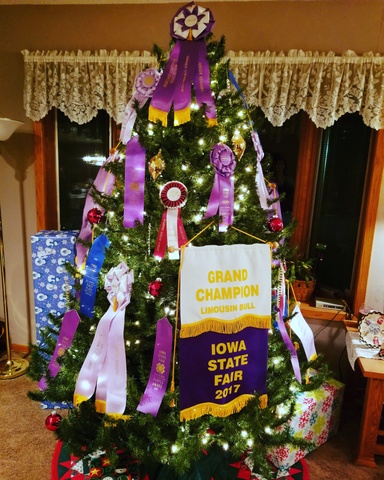
Cattle banners on the Christmas tree in Iowa
Want more?
Thanks for stopping by. I invite you to read more of my blog posts if you value intriguing Iowa stories and history, along with Iowa food, agriculture updates, recipes and tips to make you a better communicator.
If you like what you see and want to be notified when I post new stories, be sure to click on the “subscribe to blog updates/newsletter” button at the top of this page, or click here. Feel free to share this with friends and colleagues who might be interested, too.
If you’re hungry for more stories of Iowa history, check out my top-selling “Culinary History of Iowa: Sweet Corn, Pork Tenderloins, Maid-Rites and More” book from The History Press. Also take a look at my latest book, “Dallas County,” and my Calhoun County” book from Arcadia Publishing. Both are filled with vintage photos and compelling stories that showcase he history of small-town and rural Iowa. Order your signed copies today! Iowa postcards are available in my online store, too.
Also, if you or someone you know could use my writing services (I’m not only Iowa’s storyteller, but a professionally-trained journalist with 20 years of experience), let’s talk. I work with businesses and organizations within Iowa and across the country to unleash the power of great storytelling to define their brand and connect with their audience through clear, compelling blog posts, articles, news releases, feature stories, newsletter articles, social media, video scripts, and photography. Learn more at www.darcymaulsby.com, or e-mail me at yettergirl@yahoo.com.
Let’s stay in touch. I’m at darcy@darcymaulsby.com, and yettergirl@yahoo.com.
Talk to you soon!
Darcy
P.S. Thanks for joining me. I’m glad you’re here.
@Copyright 2018 Darcy Maulsby & Co.
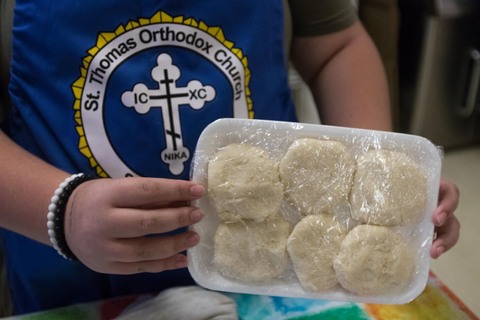
Mediterranean Delights: Iowa Ag Influences Syrian-Lebanese Church Dinner
Call it controlled chaos. Anyone who has ever helped with a church fundraising dinner knows just how hectic, harried and fun it can be to work together to prepare the meals. That’s especially true at St. Thomas Orthodox Church in Sioux City.
“It’s a lot of work and requires all hands on deck,” said Erica Stickney, a chairperson who helps coordinate St. Thomas’s popular Syrian-Lebanese dinner, which was held on Sept. 10 this year.
“While it can get a little frustrating at times when things get really busy and the kitchen’s hot, you remember that it’s about friendship and love, including love for God and the community.”

St. Thomas Orthodox Church has served the Sioux City community since 1916.
Homemade dinners at this year’s Syrian-Lebanese dinner, which was served from 12:30 p.m. to 6 p.m., cost $13 each, with a portion of the proceeds going to The Warming Shelter, a non-profit charity in Sioux City. While this year’s menu served plenty of Mediterranean favorites, many had a Midwestern twist. “Traditionally the meat would have been lamb, but we use beef, because we’re in Iowa,” Stickney said.
The menu included:
• Kibby (or kibbeh). This tasty meatloaf is made with lean ground beef and cracked bulgur wheat, seasoned with cinnamon and allspice.
• Yabrah. Much like cabbage rolls, yabrah includes cabbage leaves that are rolled and stuffed with a spiced blend of beef, rice and tomatoes. “We rolled 5,515 of these this year,” said Sue Stevens of Sioux City. “It’s rewarding to hear our guests say the cabbage rolls are perfect.”
• Lubee. This simple, yet satisfying side dish, features green beans in a tomato and meat sauce.
• Ruz. This Syrian favorite includes buttery white rice accented with tiny orzo pastas.
• Salata. This Syrian salad is enhanced with the church’s special dressing made of oil, vinegar, lemon juice and seasonings.
• Talamee. These big, round loaves of Syrian bread are indescribably tasty, report church members.
• Baklawa. Sometimes called baklava, this classic Mediterranean dessert is made with phyllo pastry dough, butter, and walnuts in a sweet syrup.
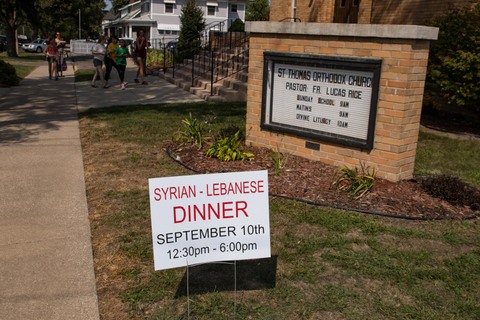
A steady stream of people stopped by St. Thomas Orthodox Church in Sioux City in September 2017 for the popular Syrian-Lebanese dinner.
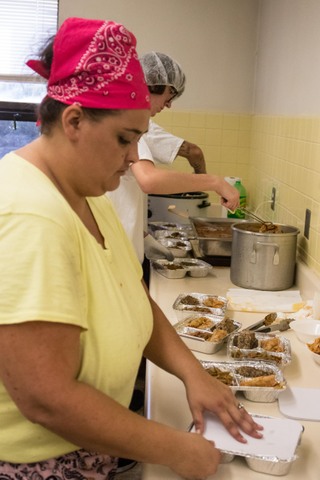
Erica Stickney, a chairperson who helps coordinate St. Thomas’s popular Syrian-Lebanese dinner in Sioux City, dished up countless carryout dinners.
Diverse influences create beloved traditions
While St. Thomas is located in the heart of Sioux City, the parish’s heritage, much like its dinner specialties, reflects a mix of Mediterranean and Midwestern influences. The church was founded in 1916 to serve the needs of Arab Christian immigrants, many of whom came to the area to work in the Sioux City Stockyards or local meatpacking plants. Today’s members embody a diverse background of Mediterranean, Russian, Serbian and Romanian heritage.
“Historically, Sioux City has been very welcoming and accepting of newcomers,” said Father Lucas Rice, who has served the St. Thomas parish more than six years. “When I came here, I was also blown away by how much the people of Siouxland love the St. Thomas church dinner.”
While no one’s sure exactly how long St. Thomas’s congregation has been hosting the dinner (anywhere from 50 years to nearly 80 years, depending on who you ask), there’s no doubt that people mourned the loss of the dinner when the church discontinued it for a few years.
“We hadn’t hosted the dinner in three years, because our church demographics were changing and the older generation was stepping down,” said Stickney, who noted that previous generations cooked without recipes and made their own phyllo dough. “The younger generation had to decide the next steps, and we decided to carry on the tradition.”
Before the older generation retired, younger cooks in the church worked side by side with the experienced cooks so they could observe each step of the process. “We would stop them as they added ingredients so we could determine the measurements and write the recipes,” Stevens said. “While we follow the recipes, we taste the food as we prepare it to make sure it’s right.”
Church members prepared to serve 1,400 dinners on Sept. 10. The process started three weeks before the dinner. “We begin by clarifying the butter,” said Stickney, who noted that 236 pounds of butter are used to prepare the cookies, rice and more. “Clarified butter has the milk solids removed and influences the taste and look of the food.”
The bread is baked on the Saturday right before the dinner, and the rest of the dishes are prepared fresh the day of the church dinner. “I love to come back for this dinner,” said Rick Stevens of Lincoln, Nebraska, whose family has been part of the St. Thomas parish for generations. “This is home.”
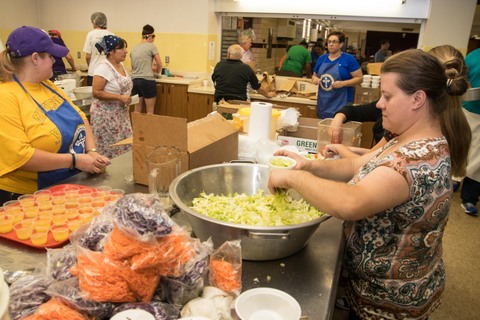
It’s all hands on deck in the basement kitchen at the St. Thomas Orthodox Church Syrian-Lebanese dinner and bake sale in Sioux City.
Clarified Butter
Slowly melt butter in pan on low heat. Be careful not to boil. When butter is completely melted, carefully skim all of the milk fat from the top and discard fat. The result is pure gold butter. This is used in most Arab recipes.
Ghraybeh (Lebanese Butter Cookies)
1 cup clarified butter
1 cup powdered sugar
2 cups flour
With hand mixer, whip butter until creamy pale and fluffy. Add sugar, and mix until fluffy. Using a large rubber spatula, blend in flour a little at a time.
Roll dough into balls and place on cookie sheet. Press to flatten. Work quickly so dough doesn’t get too soft. Bake in preheated oven (300 degrees) until cookies are firm, 10 to 12 minutes. Don’t let cookies get brown. Remove cookies from pan and let cool.
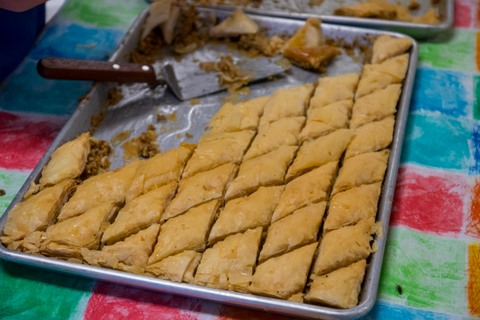
Homemade baklawa (baklava) is always in demand at the St. Thomas Orthodox Church Syrian-Lebanese dinner and bake sale.
Baklawa (also known as Baklava)
4 cups finely chopped walnuts
2 cups clarified butter-melted
1/8 cup granulated sugar
2 packages phyllo dough (20 sheets per package)
Combine walnuts with sugar and 1/4 cup butter so mixture forms a ball when squeezed in your hand.
Grease a large baking sheet with butter. Place one package of phyllo carefully on to baking sheet. Spread walnut mixture on top evenly. Carefully place second package of phyllo
on top of walnut mixture. Carefully take off top five layers of phyllo.
Butter the top layer of phyllo dough on the pan, and then place a single layer of phyllo on top of buttered layer. Repeat until all lawyers are back on to pan. Put butter on top layer. Cut into diamond shapes.
Bake in preheated, 375-degree oven for 25 minutes. Remove from oven. Pour a little butter on the top evenly. Place pan back into the oven for another 20 minutes or so, until the baklawa is golden brown.
Remove pan from oven and place on cooling rack. Immediately pour syrup mix (see recipe below) evenly on top of entire pan. Let pan sit for one day. Allow syrup to soak through the entire dessert. You may want to re-cut baklawa before removing from pan.
Syrup for Baklawa
2 1/2 cups granulated sugar
1 1/2 cups water
1 tablespoon lemon juice
In a pan, heat water and sugar until boiling. Once mixture starts to boil, add the lemon juice. Cook for another 15 minutes until the syrup starts to thicken. Remove pan from heat, and set aside to cool.
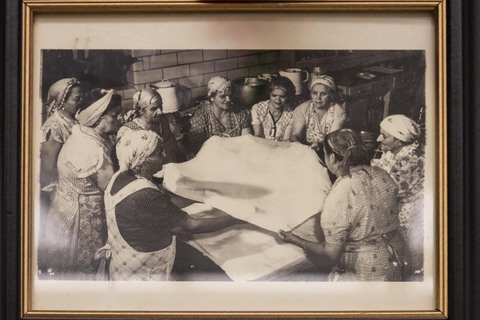
Previous generations of church members made their own phyllo dough at St. Thomas Orthodox Church in Sioux City, Iowa.
Barazek (Sesame Cookies)
1 cup butter
1/2 cup sugar
1 egg
1/2 teaspoon vanilla
3 cups flour
1/4 teaspoon salt
1 teaspoon baking powder
1/2 cup milk
3 tablespoons pistachios chopped
1 egg white
3 tablespoons sesame seeds
Preheat oven to 350 degrees. Cream butter and sugar with electric mixer until light and fluffy. Add egg and vanilla, continue beating. In separate bowl, mix flour, salt and baking powder. Stir flour mixture gradually into butter mix, alternating with milk.
Knead dough on lightly floured surface. Divide dough into two parts. Roll each piece into a circle, and cut into rounds. Place pistachios on a cookie sheet; spread evenly. Place dough rounds on top of pistachios, and press lightly. Beat the egg bite and then brush the tops of cookies. Sprinkle with sesame seeds. Bake about 15 minutes, or until golden brown.
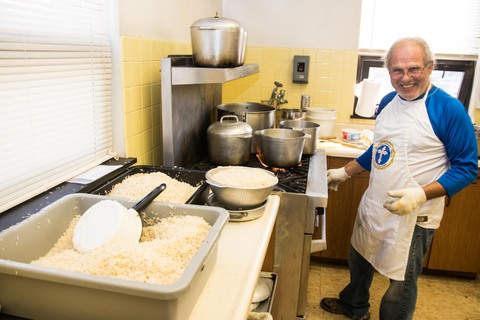
Ruz (a Syrian favorite of buttery white rice accented with tiny orzo pastas) is cooked in large quantities at the St. Thomas Orthodox Church Syrian-Lebanese dinner.
Want more?
Thanks for stopping by. I invite you to read more of my blog posts if you want more more intriguing Iowa stories and history, along with Iowa food, recipes and tips to make you a better communicator.
If you like what you see and want to be notified when I post new stories, be sure to click on the “subscribe to blog updates/newsletter” button at the top of this page. Feel free to share this information with friends and colleagues who might be interested, too.
If you’re hungry for more stories of Iowa history, check out my top-selling “Culinary History of Iowa: Sweet Corn, Pork Tenderloins, Maid-Rites and More” book from The History Press. Also take a look at my latest book, “Dallas County,” and my Calhoun County” book from Arcadia Publishing. Both are filled with vintage photos and compelling stories that showcase he history of small-town and rural Iowa. Order your signed copies today! Iowa postcards are available in my online store, too.
Let’s stay in touch. I’m at darcy@darcymaulsby.com, and yettergirl@yahoo.com.
P.S. Thanks for joining me. I’m glad you’re here.
@Copyright 2017 Darcy Maulsby & Co.
